

How to Add Presenter Notes in Keynote on Mac, iPhone, and iPad
In this article, I will explain how you can add presenter notes to your slides in Keynote on your Mac, iPad, or iPhone.
When you are creating a presentation, for every slide, you can add presenter notes (also called speaker notes) to provide reference material for you, as the speaker or presenter, when you are presenting a slideshow in front of an audience. For example, these notes may help you recall important points during your presentation. These notes will only show up on your screen. They aren’t visible to the audience. You can also print these notes.
- Open, Edit & Create a Keynote File (.Key) in PowerPoint on Windows PC
- Easiest Way To Open / Edit a .Pages File On a Windows PC
Add presenter notes in Keynote on Mac
Follow the steps below:
1 . Open Keynote and create your presentation. Select the slide you want to add notes to. When you are ready to add a note to a slide, click the View button in the toolbar.
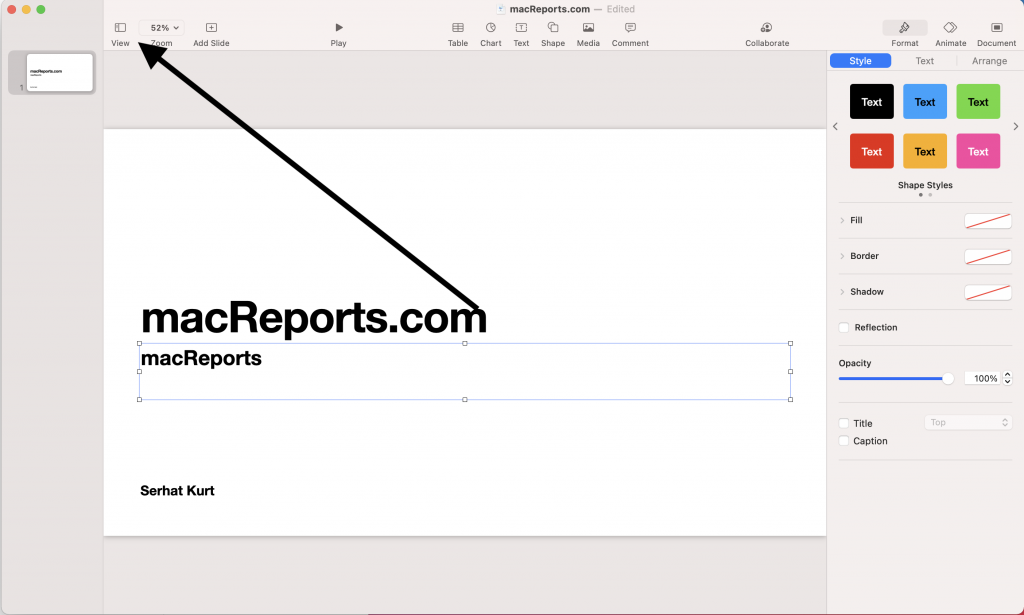
2 . This will open a menu, from the menu items, click Show Presenter Notes.
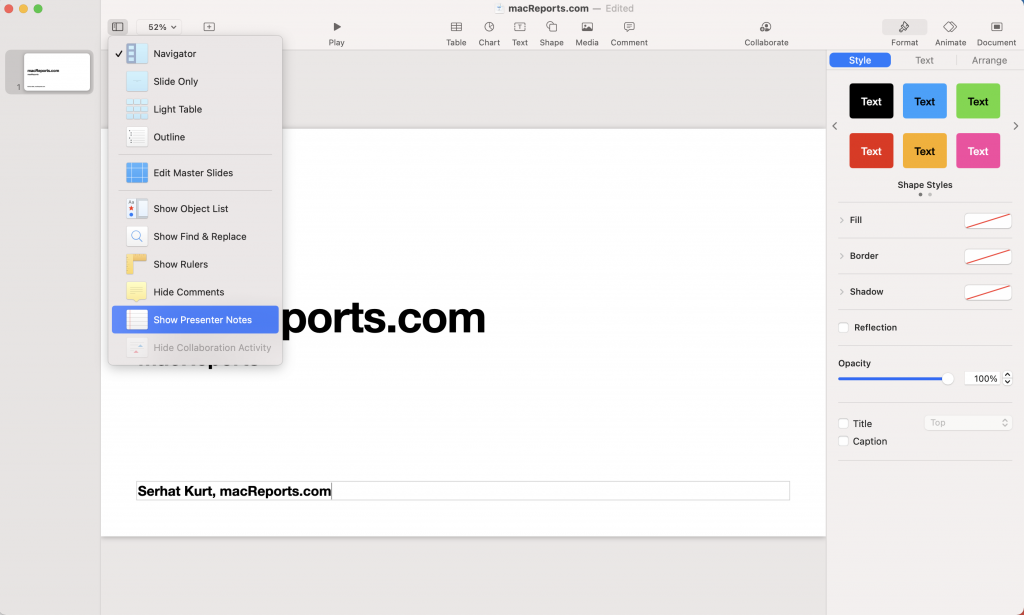
3 . The notes pane (a white area) will appear under your slide. Click the white area to add notes and type whatever you want.
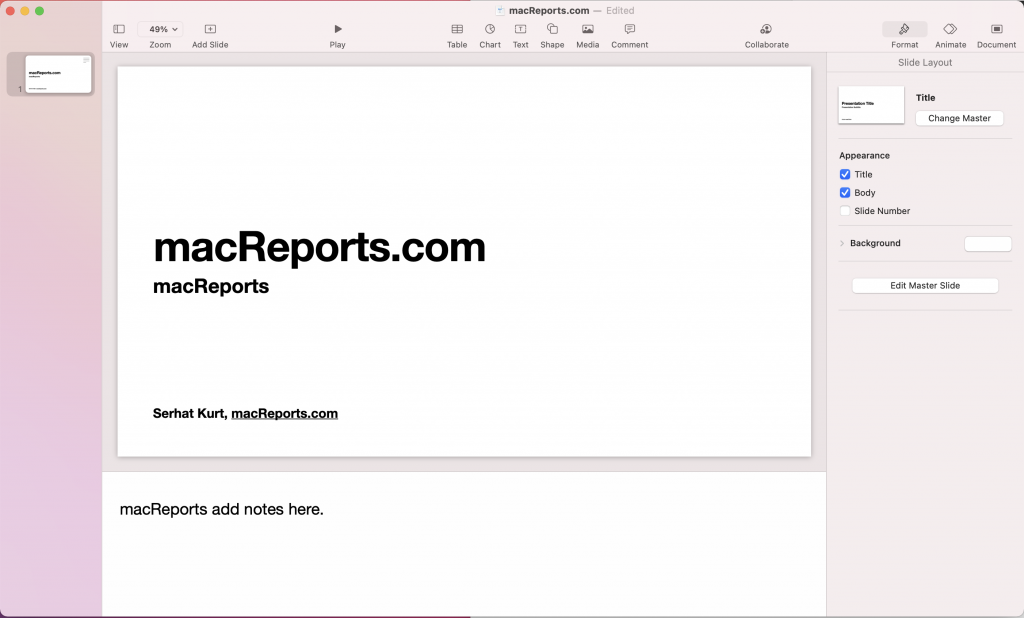
And you are done. To hide the notes area, again click the View button and click Hide Presenter Notes.
See also: Apple .Pages File Extension – Everything You Need To Know
Add presenter notes in Keynote on iPhone
If you are creating your presentation on an iPhone, here is how you can add notes.
1 . In Keynote on your iPhone, select the slide and then tap the three-dot (…) more icon.
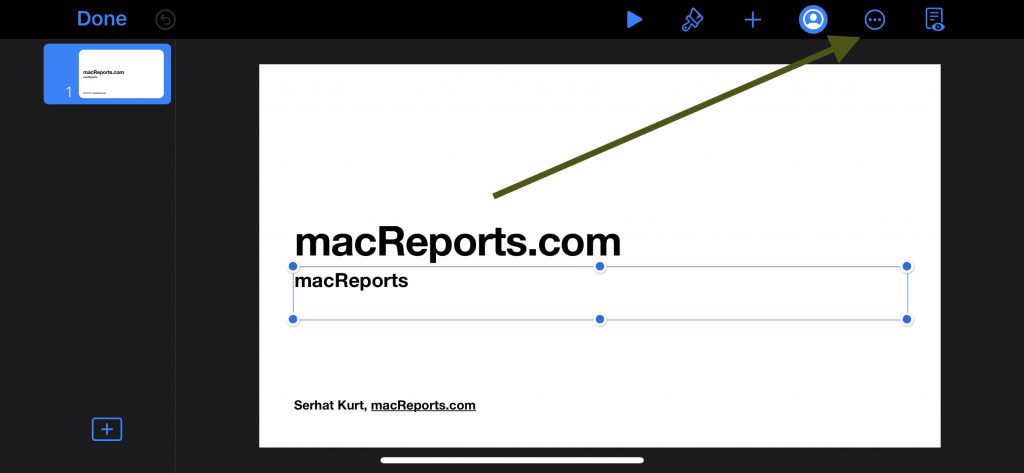
2 . This will open a new menu. Find the “Show Presenter Notes” option and turn this on and then tap Done.
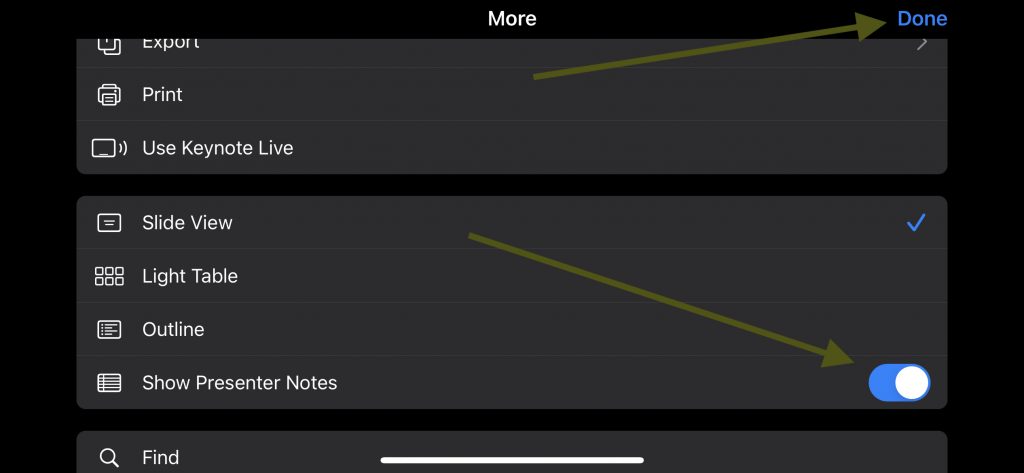
3 . This will open the notes area at the bottom of your screen. Tap the field to add notes. You can swipe up or down the field.
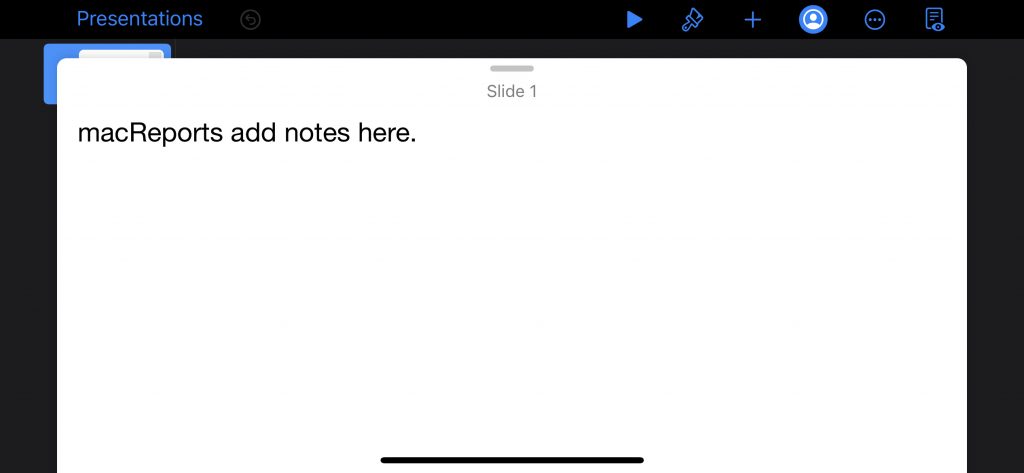
4 . You can hide this field after you have done adding your notes. Again tap the More icon and turn off the Show Presenter Notes option.
Add presenter notes in Keynote on iPad
If you are using your iPad to create a Keynote presentation, here is how you can add presenter notes.
1 . Open your presentation on your iPad and tap the slide you want to add notes to. And tap the Presenter tools icon on the top left.
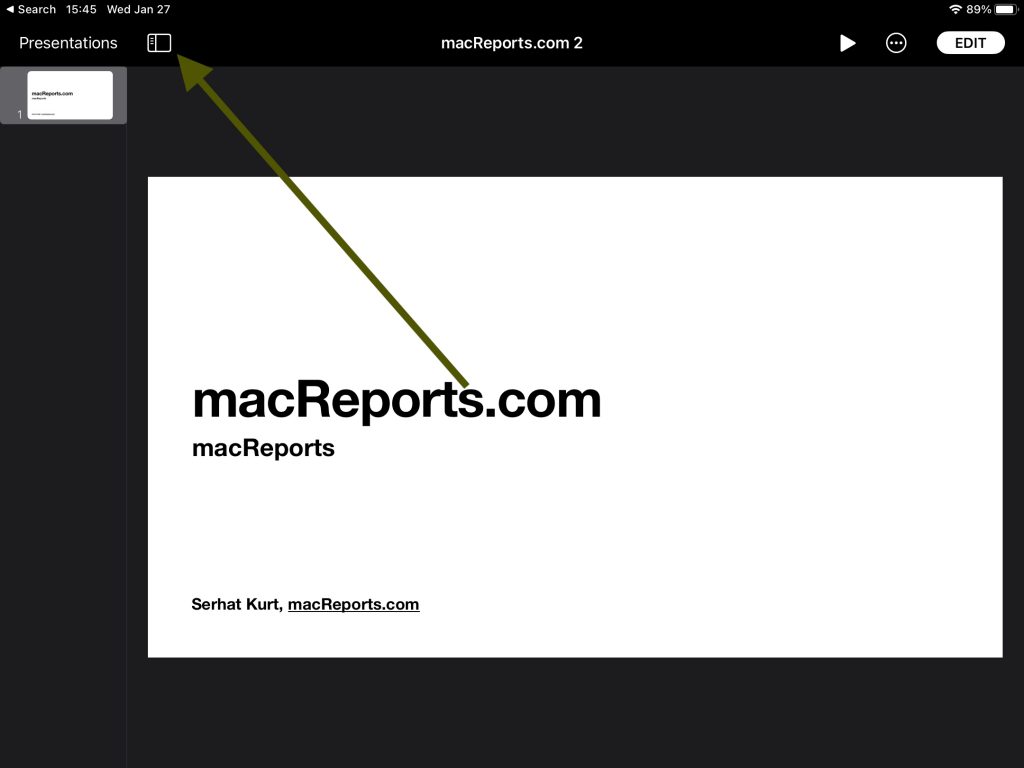
2 . This will reveal a menu. And turn on Show Presenter Notes.
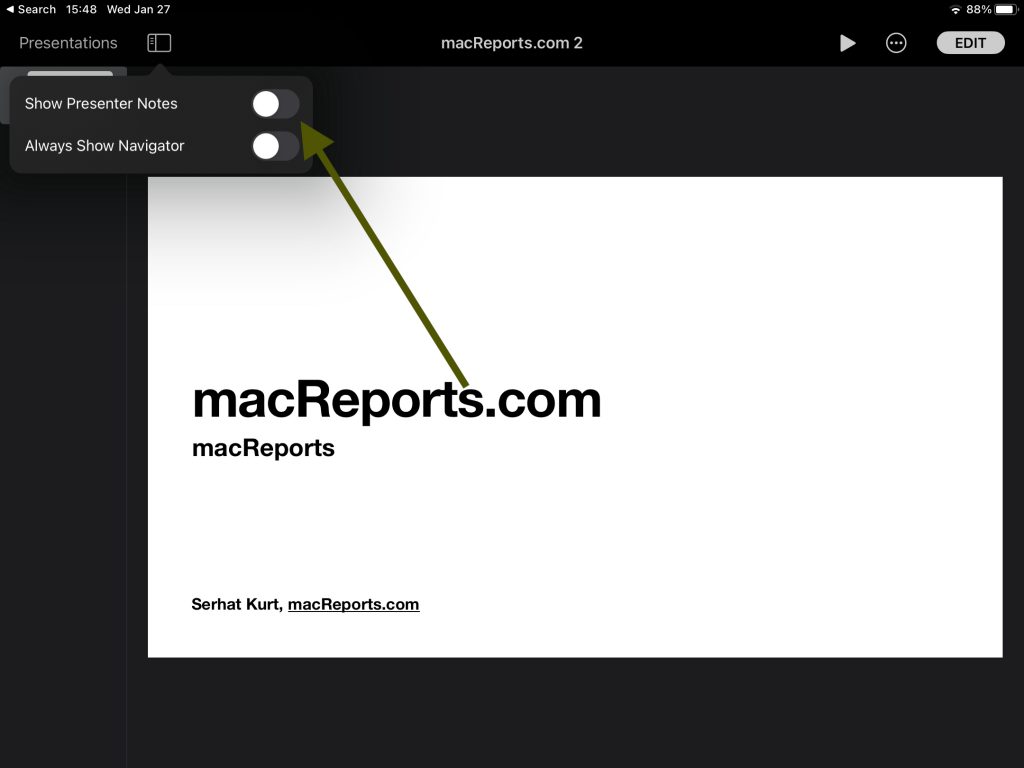
3 . This will open the notes field. Tap the text field to add notes. To hide the text field, turn off the Show Presenter Notes option.
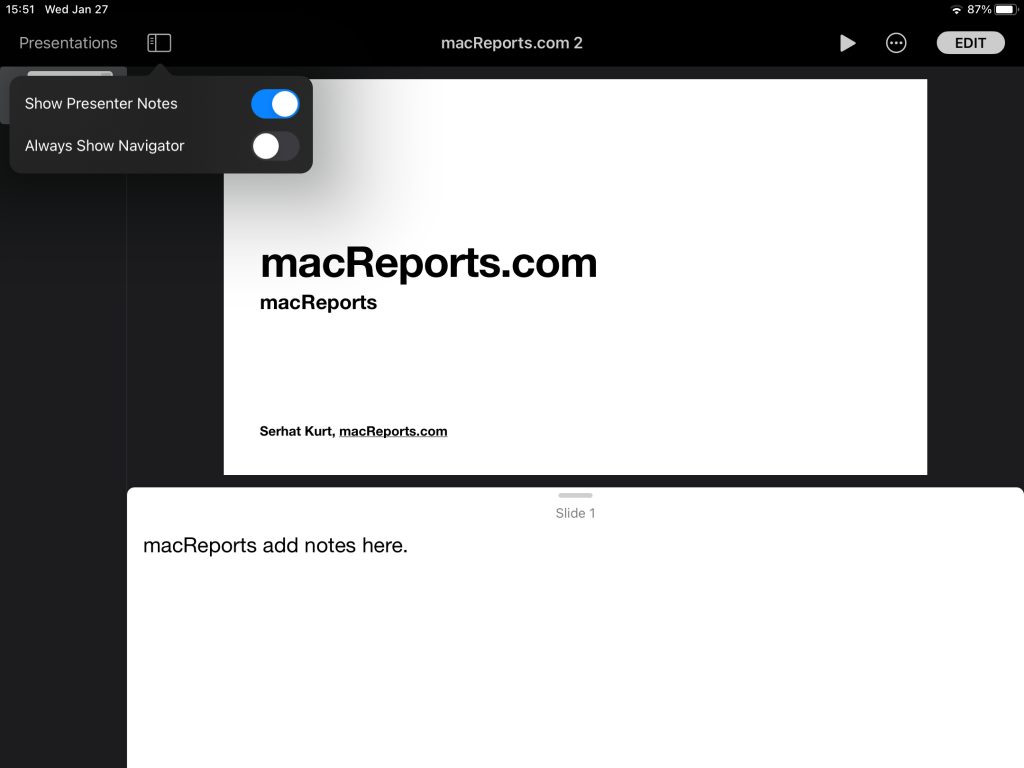
So, you may wonder now how you can view your notes while you are delivering the slideshow. You can view your notes when you are showing your presentation on a connected display. If you have one screen, the notes you add will not be visible in Play mode, unless you are using the rehearsal mode by tuning on “Rehearse Slideshow”.
See also: Pages: Can’t Open Document, Fix
Dr. Serhat Kurt worked as a Senior Technology Director specializing in Apple solutions for small and medium-sized educational institutions. He holds a doctoral degree (or doctorate) from the University of Illinois at Urbana / Champaign and a master’s degree from Purdue University. He is a former faculty member. Here is his LinkedIn profile and Google Scholar profile . Email Serhat Kurt .
Similar Posts
A complete list of stores that accept apple pay [2024 updated].
This article lists retailers and stores that are currently accepting Apple Pay. Apple Pay lets you pay online or make contactless payments with your iPhone, iPad, or Apple Watch. A lot of users…
How to Share Files and Folders in iCloud Drive
With iCloud File Sharing, you can share folders and documents from your Mac, iPhone or iPad with other iCloud users. You may be familiar with this from using other cloud services like Dropbox….

Pipidae Will Damage Your Computer Popup on Mac
If a popup message appears on your Mac saying, “‘Pipidae’ will damage your computer. You should move it to the Trash,” you may wonder what this means and if you are infected with…
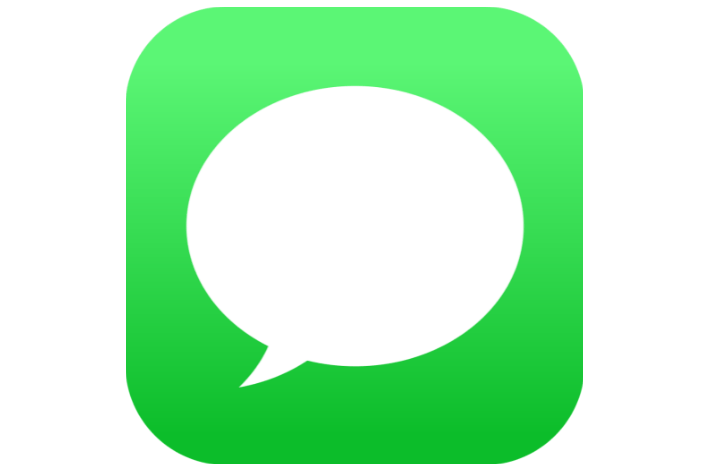
Does iMessage Notify You When Someone Takes a Screenshot?
Are you worried about notifying others when you take a screenshot in Messages (iMessage)? Well, screenshot taking notifications in the Messages app simply do not exist. This includes screenshots taken in Messages on…
Mac Keeps Freezing? How To Fix
Does your Mac keep freezing and stop responding, randomly and unexpectedly? There can be a number of reasons that can cause your Mac to become unresponsive to any user input from the keyboard…

Is Potential Spam Calling You? What Does That Mean?
Sometimes you may get calls saying, “Potential Spam” in the caller ID section of your call screen instead of a caller id, contact name, or number. You may wonder who this is, what…
My keynotes presenter page shows various lengths of page. Some can be scrolled down others I have to shorten the notes or show two identical slides with half the notes for one and the other half on another slide.
Is there a way of making all the pages longer. I can make them wider and as long as my screen is high, but the text just fills up the page when I do that.
Can you use a smaller font in order to fit more notes?
Leave a Reply Cancel reply
Your email address will not be published. Required fields are marked *
Categories:
Unsupported browser
This site was designed for modern browsers and tested with Internet Explorer version 10 and later.
It may not look or work correctly on your browser.
- Learning Guides
How to Use Apple Keynote (Ultimate Tutorial Guide)
In this guide, you'll learn the basics of how to use Apple's Keynote presentation software. Learn all about Keynote whether you're a complete beginner or trying to improve on your existing skills.
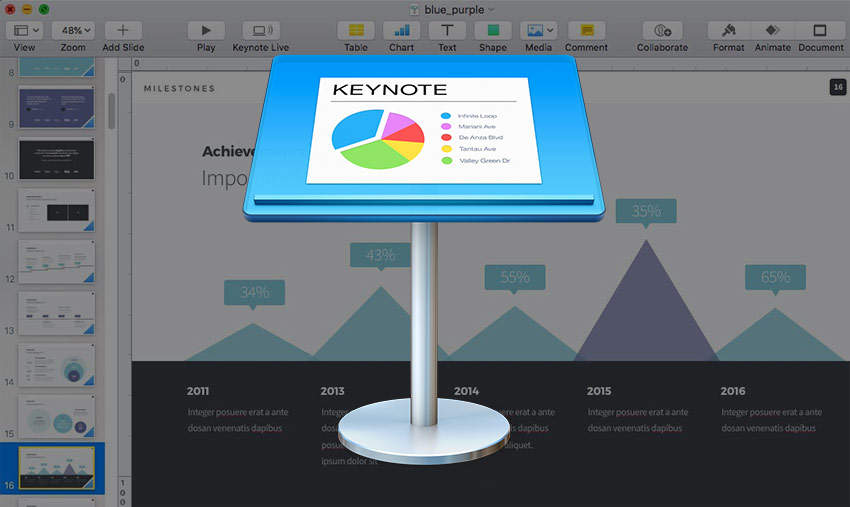
Apple Keynote is slideshow presentation software that features an elegant and easy-to-use interface. You'll be creating great presentations in no time. It's built into Mac computers, making it a great choice for Mac users. Also, Keynote files can easily be converted to Microsoft's PowerPoint if necessary.
How to Use Keynote to Make Powerful Presentations
One of the best ways to create a powerful presentation with Keynote is to download and use a template. There are hundreds of professional Keynote templates you can use available through Envato Elements and GraphicRiver . Here are some examples of just a few of them:

How to Use this Tutorial
Learn all about using Keynote, from setting up your slide designs to working with text, images, video, charts, multi-media, and more. Learn how to work with Keynote's core presentation tools to make great presentations quickly.
If you only have a few minutes to spare, then be sure to watch a few of our one-minute Keynote tutorial videos. Otherwise, jump into one of these comprehensive beginner tutorials.
Note : Be sure bookmark this Apple Keynote tutorial guide to start working through each tutorial at your own pace.

What Is Apple Keynote Software? +How to Start Using It to Make Presentations

How to Create a Basic Keynote Presentation (On Your Mac)

How to Make a Great Presentation in Keynote With Template Designs
How to Use Keynote Slides (Layout Dimensions, Sizes, & Design)
How to Add Pictures & Backgrounds in Keynote Presentations
.jpg)
How to Rotate Text & Shapes in Keynote in 60 Seconds
Keynote Magic Move: How to Use Slide Transition Effects

How to Quickly Make a Timeline in Keynote With Templates
How to Add Video & Music Files in Keynote Presentations
How to Make Flowcharts & Gantt Charts in Keynote With Templates

How to Use Apple Keynote Live to Stream Presentations on the Web
How to Convert Keynote to PowerPoint (PDF, & More) on Export (+Video)
How to Convert PowerPoint (PPTX) for Mac Keynote Presentations (W/Video)
.jpg)
How to Quickly Change Keynote Custom Themes (In 60 Seconds)

What is the Apple Keynote App Advantage? (Create Presentation Designs Simply)

Keynote for Apple Mac: 15+ Top Presentation Tips & Tricks for 2019

How to Create a Keynote Presentation Template Design

Preparing Your Mac for a Presentation
Getting Started With Keynote on OS X
Keynote - Adding Presenter Notes
Keynote > adding presenter notes.
Change Language
Use presenter notes, add presenter notes to your slides, add and edit notes for a slide, view presenter notes while playing your presentation.
How to customize the presenter display in Keynote
In this tutorial, we will help you customize the presenter display feature in the Keynote app on your Mac, iPad, and iPhone so you’re ready for your next presentation.

Do you present a lot of slideshows using Keynote or at least enough that you’d like to make things a bit easier? One way to do this is by taking advantage of the presenter notes feature, but another is customizing the presenter display.
When you show a presentation in Keynote, you can configure the screen you see as the presenter. Whether for comfort or easy access to items, setting up that view for what works best for you can lead to a successful presentation.
Related: How to work with Keynote Presenter Notes on Mac and iOS
Customize the Keynote presenter display on Mac
Open your slideshow in Keynote. You can either play your presentation, use the Rehearse Slideshow mode, or jump right into customizing the display.
- #1 Click the Play button in the toolbar.
- #2 Click Play in the menu bar and select Play Slideshow or Rehearse Slideshow .
- #3 Click Play in the menu bar and select Customize Presenter Display .
If you choose #3, you’ll go directly to the customization options and skip the first group of settings you can adjust. For this tutorial, we’ll customize the display using #1 or #2 above so that you can see the first group of settings.
1) On the presenter screen (Play > Rehearse Slideshow), click the Layout Options button at the top. This is the square icon to the right of the Help button (question mark).
2) Here, you can check or uncheck the items available. This includes the current slide, next slide, presenter notes, ready indicator, clock, and timer.
If you check the Timer setting, you can then pick from displaying elapsed or remaining time. This is a terrific way to stay on track with longer presentations.
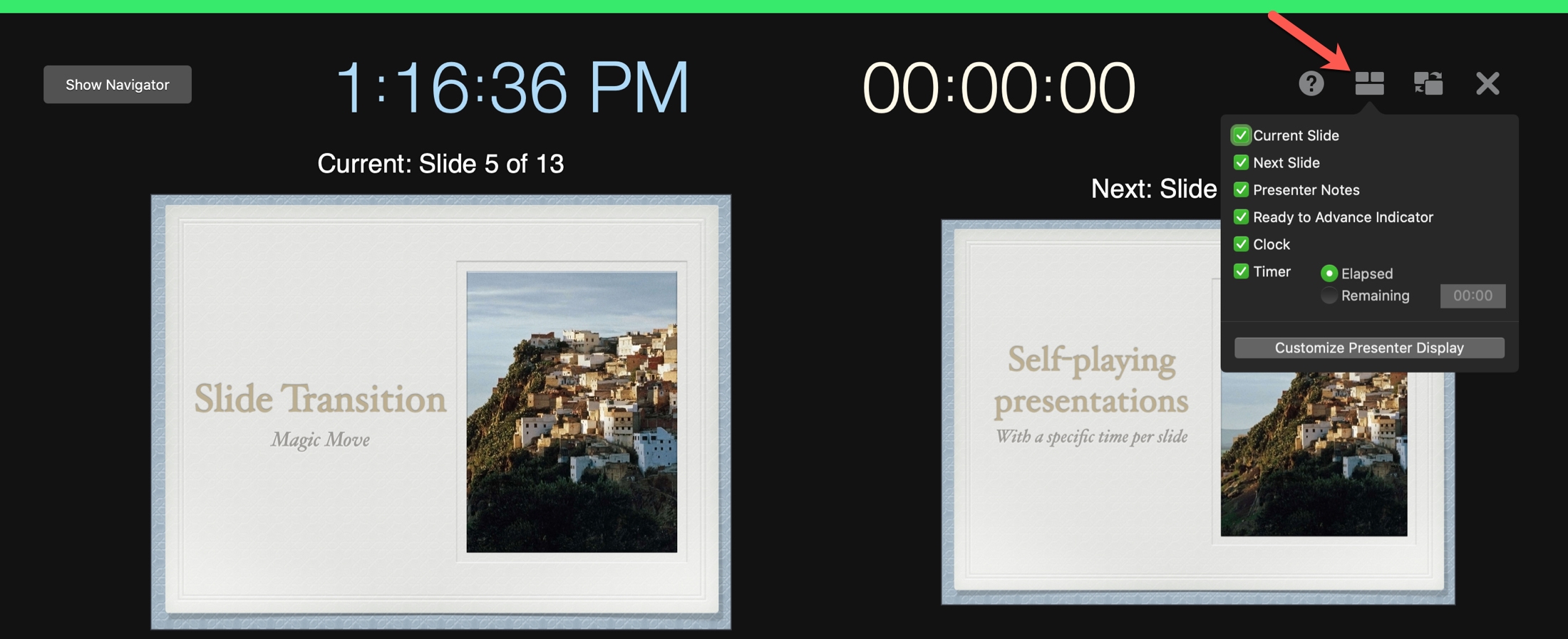
3) To change the layout of the display, click Customize Presenter Display in that small window.
4) You’ll then see those same checkboxes, and you can adjust them here if you like.
In addition, you can move, resize, and position items, as well as change the appearance of your presenter notes.

Move items : Click and drag elements to different locations on the screen. By default, slide labels move with the slides, but you can drag a label separately if you like. To move multiple items at once, hold the Command key and click each one. You can then move the selected group.
Resize items : Drag a corner or edge of an element to resize it. To retain an item’s proportions when you resize it, hold the Shift key as you drag. To proportionally resize from the center of an item, hold the Shift and Option keys as you drag.
Automatically position items : Click the Use Auto Layout button.
5) When you finish customizing your display, click OK .
Customize the Keynote presenter display on iPhone and iPad
While it’s easier to present a Keynote slideshow on Mac, in my opinion, that might not be an option for you. So here are the steps to access the customization settings for your presenter display on iPhone and iPad.
1) If your external display is connected, tap Play . If not, select tap the More button (three dots) on the top right and select Rehearse Slideshow .
2) On the top right, tap the rectangle that displays your Layout Options. This is to the left of the X to stop the slideshow.
Tap the layout view you want to use from options like current or next slide, slides with notes, or notes only.
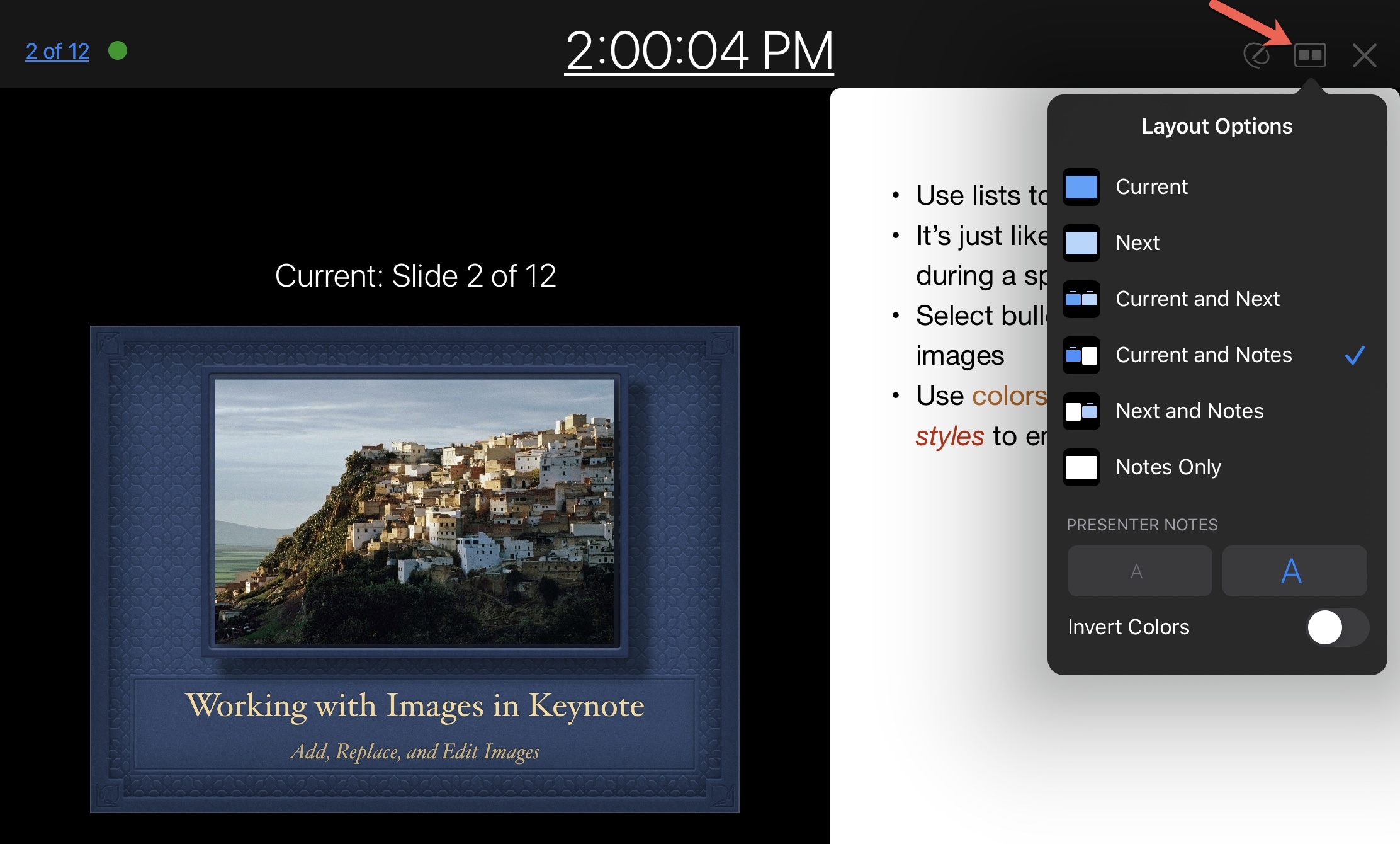
3) Below Presenter Notes , you can increase or decrease the font size of your notes or invert those colors.
By default, the clock displays at the top. If you tap it, it will switch to the timer with elapsed time.
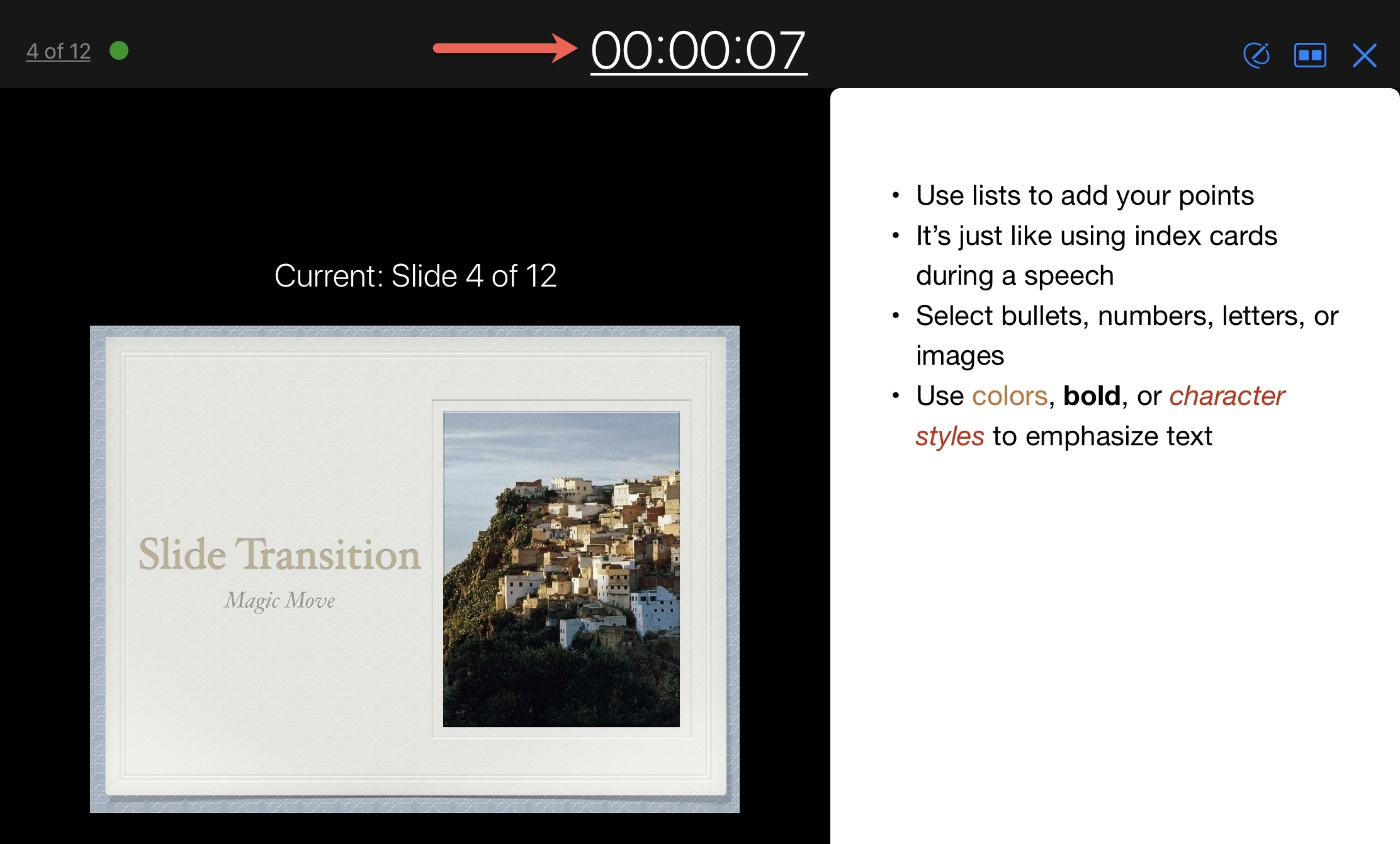
You don’t have as many customization options for the presenter display on iPhone and iPad as you do on Mac. But those you do have should help to get your display in a way that works for you.
With some small adjustments, you can create the perfect presenter display to move through your Keynote slideshow. Are you going to keep these options in mind for your next presentation?
For more, check out:
- How to add backgrounds and borders to Keynote slides
- How to gain more workspace around your slides
20 Fantastic Tutorials for Learning & Mastering Apple Keynote
Learning how to use Apple Keynote is key to creating engaging presentations. Beginners can quickly grasp the basics, while professionals can explore advanced techniques to expand their skills. Keynote offers a range of features, including animations, transitions, and effects that can transform standard presentations into stunning slideshows.
There are many Keynote learning resources available for users at all levels. These resources cover everything from basic setup and slide design to complex animations and interactive elements. Knowing how to use Keynote’s features is essential for creating business presentations, educational materials, or creative projects.
This collection shares the best tutorials for learning Apple Keynote. It includes resources for different skill levels, providing valuable insights and tips for everyone. Explore these tutorials, improve your presentation skills, and maximize the potential of Apple Keynote.
You might also like our collection of free Keynote templates .
The Best Tutorials for Learning Keynote
What is apple keynote.
This tutorial is perfect for anyone new to using Keynote. The tutorial covers everything you need to know about Keynote so you can start making beautiful presentations quickly.
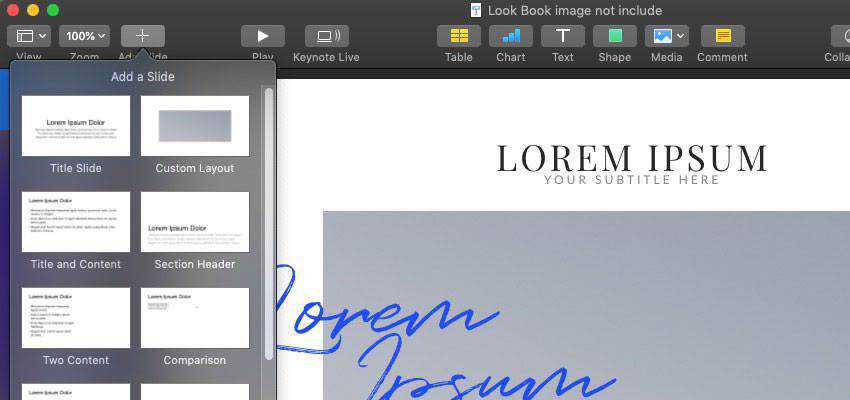
How To Create Your First Keynote Presentation
Once you know the basics, this tutorial will teach you how to use Keynote to create your first presentation and show you tips and tricks for getting the most out of your presentations.
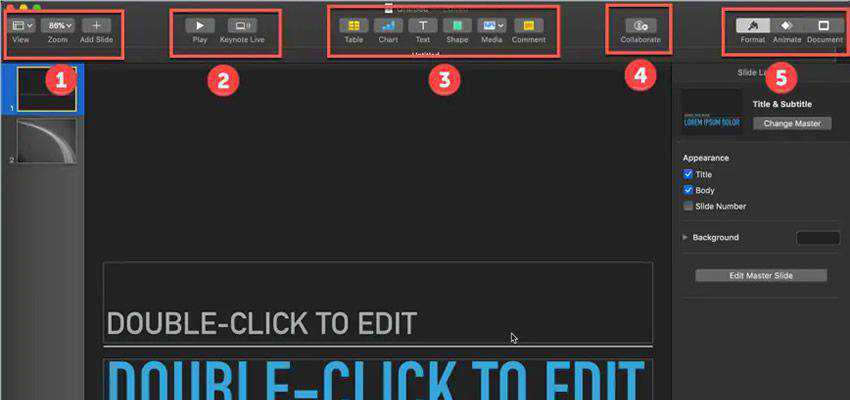
How to Make Animated Videos with Keynote
Keynote makes it easy to create beautiful presentations, but that’s not the only thing you can use it for. In this tutorial, you will learn how to create animated videos – with Keynote!
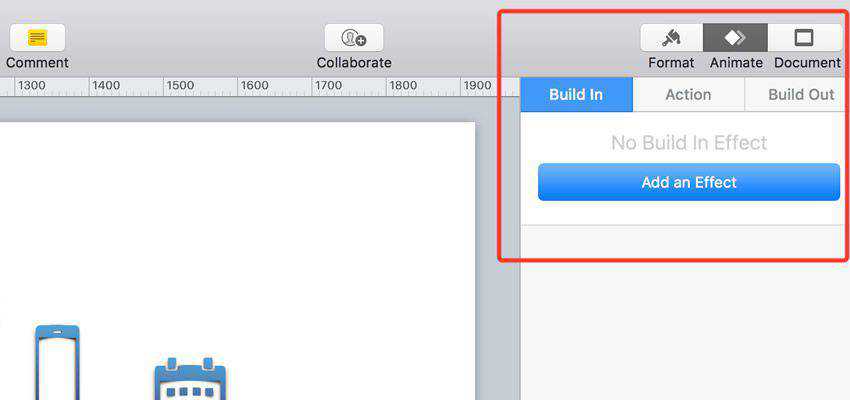
How to Add Animations in Apple Keynote
Animation can make your presentations more exciting and help keep your audience engaged. This tutorial will show you how to easily add animations to your Keynote presentations.
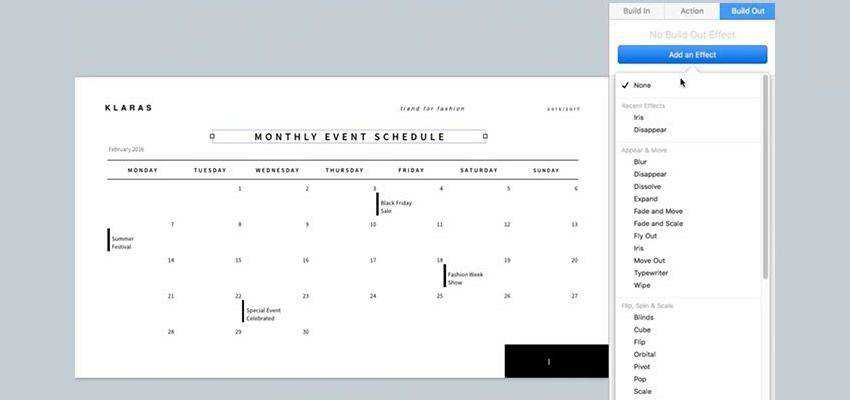
How to Use Slide Transition Effects in Keynote
Learn how to add beautiful slide transitions to your Keynote presentations with the help of Magic Move . This handy feature allows you to animate slides as well as objects between slides.
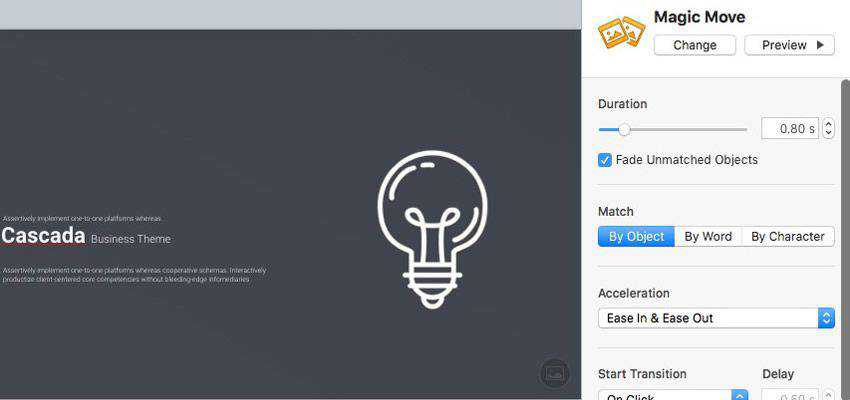
How to Use Keynote Live to Stream Presentations
Thanks to technological advancements, your audience doesn’t need to be in the same room to view your presentation. With Apple Keynote Live, you can easily stream presentations on the web. Learn how to do it with this tutorial.
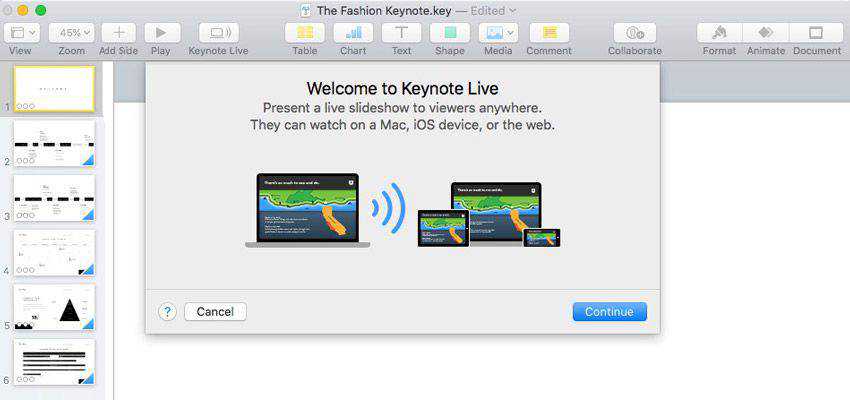
How to Create Animated Videos in Keynote
Don’t spend money on expensive software if you only need to create short animated promotional videos. Instead, use this tutorial to learn how to create animated videos in Keynote.

How to Create a Ken Burns Effect in Keynote
Learn how to make your presentations more visually appealing by panning and zooming across an image. This effect, known as the Ken Burns effect, can easily be applied in Keynote.
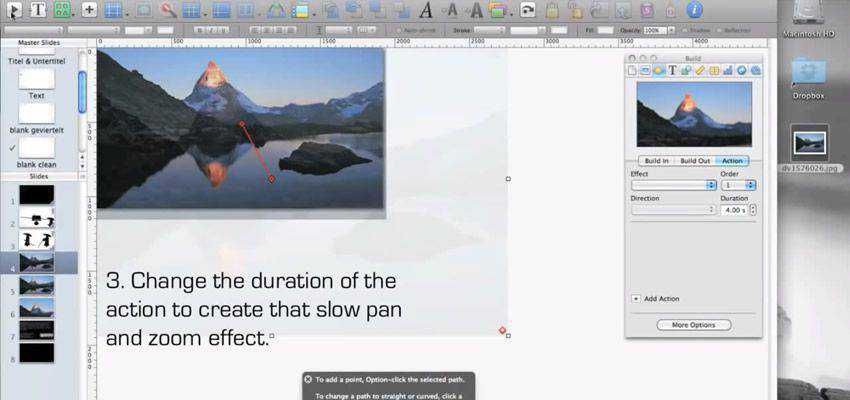
How to Create Dynamic Keynotes
This quick tutorial will show you how to make more dynamic Keynote presentations that capture your audience’s attention. Tips cover Magic Move, background images, gradient fills, and more.

How to Create a Keynote Scroll-Based Parallax Animation
In this video tutorial, you will learn a creative method of using Keynote to mimic the parallax effect and create a realistic website mockup for your clients.

How to Add a Video Background to Keynote Presentations
Video background is a surefire way to add extra interest to your presentations. This tutorial will walk you through the steps for adding a video background to your Keynote presentations.
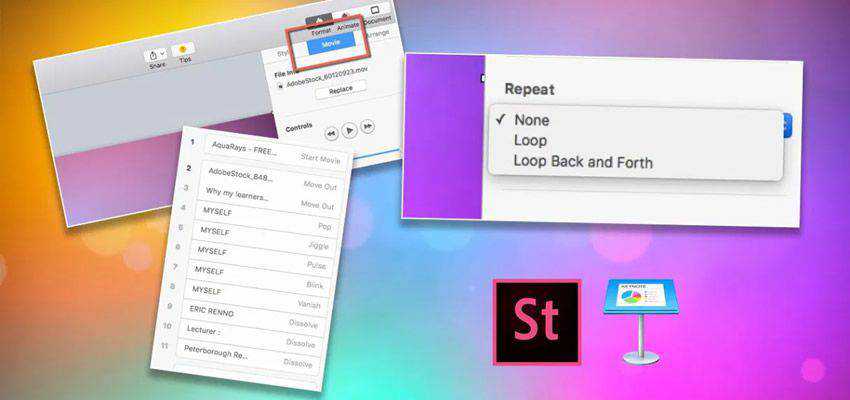
How to Add Presenter Notes in Keynote
Forget about making presenter note cards or using index cards to ensure all your points are covered. Learn how to use Keynote’s built-in features to add presenter notes to your presentations.
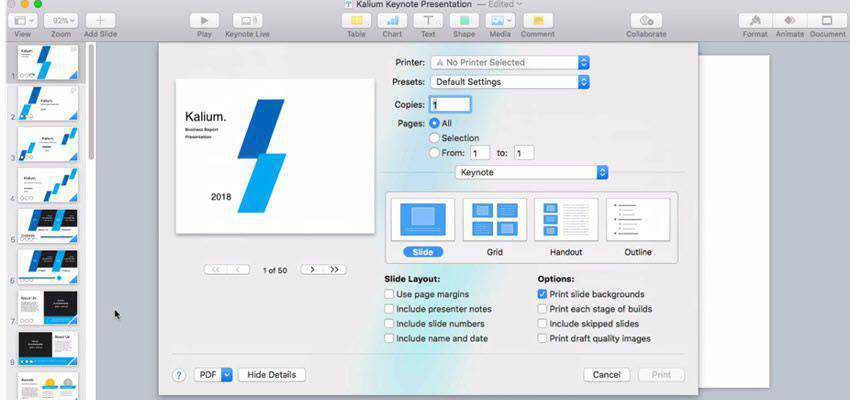
How to Create an Animated YouTube Intro with Keynote
Are you thinking of becoming a YouTuber or simply want to learn video marketing? Use Keynote to make an animated YouTube intro for free and use it in your video marketing campaigns for consistency.
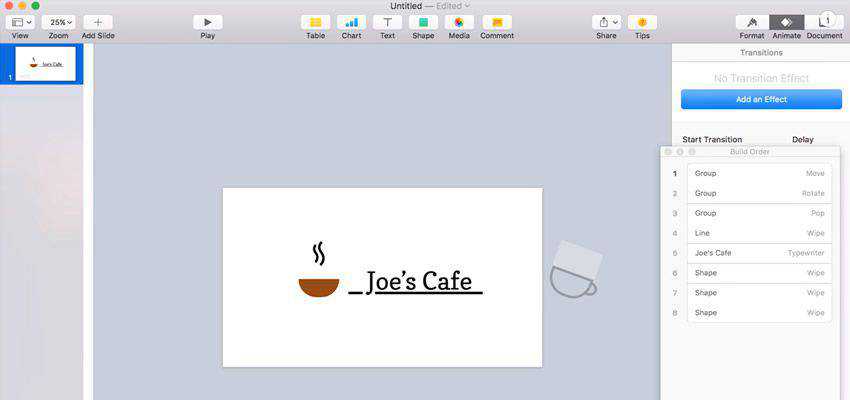
How to Create Custom Shapes in Keynote
Keynote comes with a variety of built-in shapes, but there are times when you need a custom shape. Keynote has a range of great tools that will help you create custom shapes, and this tutorial shows you how.
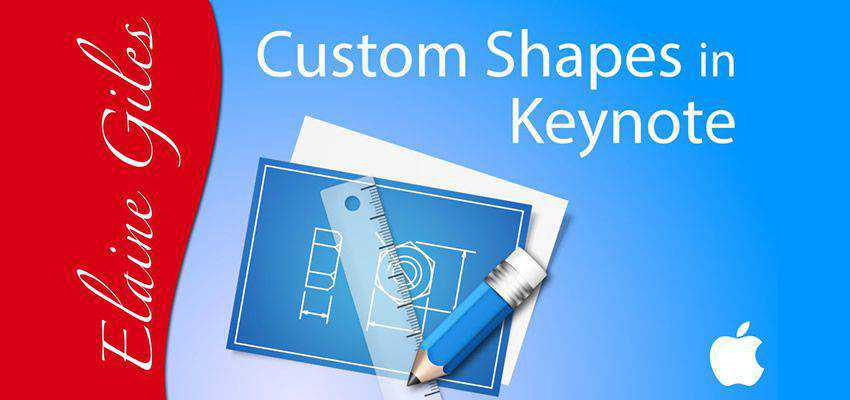
How to Add Video & Music Files in Keynote
In this tutorial, learn how to quickly add video and music files to your Keynote presentations. This is useful for many types of school or portfolio presentations.
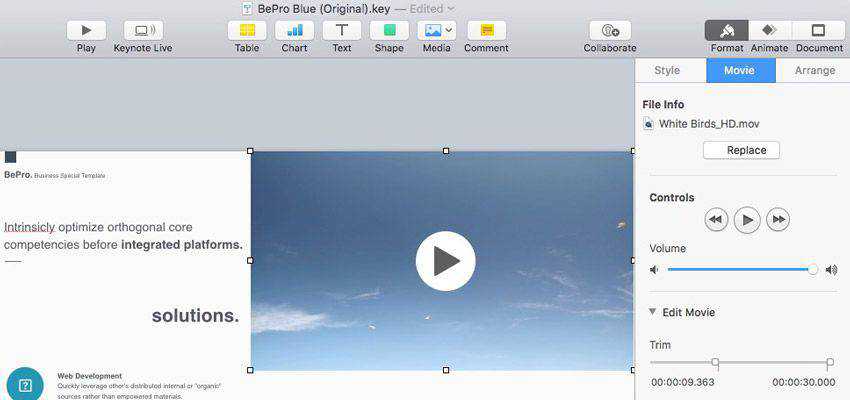
Going Deeper with Keynote
Are you looking for an easy way to upgrade your presentations? Check out this tutorial on four easy tools and features to add to your presentations and make the most of Keynote.

Apple Keynote for iPad Tutorial
If you have an iPad, you can easily create a presentation using Keynote for the iPad . This tutorial will give you a complete overview of the mobile version of Keynote and how to use it to create presentations.
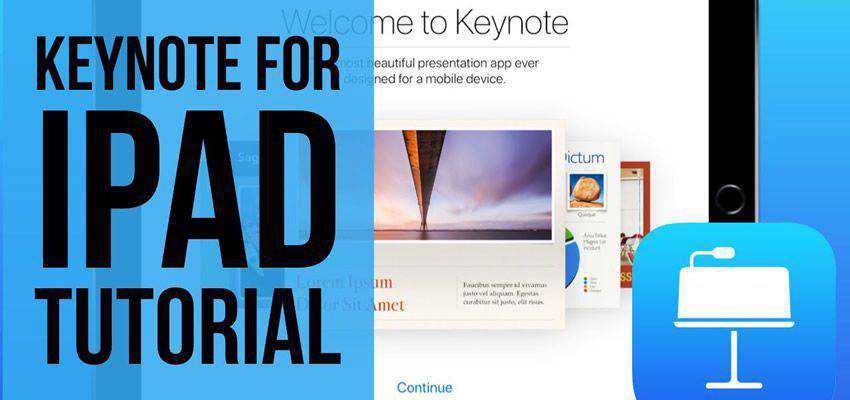
5 Useful Keynote Tips
Become a Keynote master by learning these five tips that will help you speed up your presentation design process and create better presentations.
10 Keynote Tips & Tricks
In this tutorial, you will learn a few advanced tips and tricks for using Keynote, allowing you to take your presentations to the next level and wow your audience.
Apple Keynote FAQs
- Can Beginners Learn Keynote Through These Tutorials? Yes, beginners can learn Keynote with these tutorials, as they often start from the basics and gradually cover more advanced features.
- Do These Tutorials Cover Basic or Advanced Features of Keynote? They cover various topics, from basic slide creation and formatting to advanced animation and interactive elements.
- How Long Does It Take to Learn Keynote Using Tutorials? The time it takes varies depending on your starting skill level and the complexity of the tutorials, but you can learn the basics in a few hours.
- Are Keynote Tutorials Suitable for Professional Presentation Design? These tutorials can equip you with the skills to design professional presentations for business or academic purposes.
- Can These Tutorials Help with Presentation Design and Layout? Along with technical skills, these tutorials provide tips on effective presentation design, layout, and how to keep your audience engaged.
- Do I Need Any Special Equipment for these Keynote Tutorials? All you need is a Mac or an iOS device with Keynote installed to practice along with most tutorials.
From introductory tutorials that cover the fundamentals of Keynote to advanced tips and tricks that can help you add custom animations and effects to your slides, there’s something here for everyone.
Why not try these tutorials and see how they can help you create better presentations?
Related Topics
- Apple Keynote
Getting Started With Keynote: How To Create Your First Keynote Presentation

If you’re new to the Apple ecosystem, then you’re probably a stranger to Keynote, Apple’s very own presentation software. Don’t worry if you don’t know anything about it at this point, that’s what this article is for. So, stay tuned as I introduce you to this popular alternative to PowerPoint. You’ll learn how to navigate the Keynote workspace and later on, how to create your first Keynote presentation.
Why Use Keynote?

I’ve got a few good reasons why Keynote is an awesome presentation software for Mac users.
- It’s free and readily available
Keynote comes pre-installed on new Macs. You don’t need to download it, but if you need to, you can always download it for free on the App Store . For the PowerPoint (and Windows) faithful who’ve made the switch to Apple computers, you’re probably asking this very question right now:
“Why use Keynote when PowerPoint is available on Macs?”
Truthfully, the answer is you don’t have to. However, PowerPoint (and Microsoft Office) isn’t free. If you want to install PowerPoint on your Mac, then you’d need to buy a Microsoft Office license or a subscription to Office 365.
If you absolutely don’t need to use PowerPoint, then why not give Keynote a try? It’s pretty simple to use, it’s intuitive and it works great on Macs. Plus, it’s free, so you don’t need to spend extra cash just to use the app!
- It’s designed for Macs
Keynote was designed by Apple for Apple. This means you’re not going to find Keynote on Windows or Linux or any other operating system. Apple is known for the quality of their products and Keynote is no different. It’s sleek, sexy, easy on the eyes, and it’s fairly easy to use.
For those saying they’d stick to PowerPoint on their Mac, that’s absolutely fine. But if you’re expecting your Mac PowerPoint experience to be on par with your Windows experience, then you’re going to be disappointed. The Mac version lacks many of the newer features you’ll find on Windows. And frankly, it’s just not as good as the Windows version.
If you need to use PowerPoint on Mac, I recommend you use Boot Camp or install third-party software like Parallels Desktop . This is so you can run Windows apps natively on your Mac.
- It’s user-friendly
Apple products are designed to work out of the box. It’s one of the reasons why many people swear by Apple products. You don’t need to be a designer to use Keynote. The interface is clean, intuitive and relatively simple. Sure, there’s a bit of a learning curve, but it’s nowhere near the time you need to spend to master PowerPoint.
If you’re coming from PowerPoint, you may even think Keynote is too simple. But that’s why Keynote users love it – they don’t need to overthink their slide designs. You may not have granular control over every single aspect of your presentation (and this may be a no-no for diehard PowerPoint users), but plenty of Keynote users don’t mind. When all is said and done, they know they’ll have a great-looking presentation.
- Works on all Apple devices
If you’ve invested heavily into the Apple ecosystem, then Keynote should be your presentation software of choice. Why? Because you’re not limited to using just one device to edit your slides. You can work on your slides on your MacBook, iMac, iPad, and even your iPhone! You can even access your Keynote file on non-Apple devices – simply fire up a web browser and go to iCloud Keynote!
- It’s PowerPoint-friendly
Ah yes, PowerPoint users need this reassurance. You’ve probably been burned in the past when PowerPoint and Keynote didn’t play too well with each other. And you had all sorts of problems trying to sort out compatibility issues.
Well, it’s 2019 now. According to Apple themselves, they’ve redesigned Keynote to work better with Microsoft Office products. They regularly update the software too to ensure better compatibility.
Here’s an article detailing the compatibility of Keynote with PowerPoint. You’ll notice there are more ticks in the Supported and Partially Supported columns than the Not Supported one. So, hurray for PowerPoint and Keynote fans!
Getting Started With Keynote
Now that you know just how awesome Keynote is, I’m going to give you a rundown of the software’s interface. To get started with Keynote, launch the app from the Launchpad or look for it in the Dock. You’ll then see the theme chooser (see screenshot below). Choose whether you want to use a standard (4:3) or wide (16:9) theme.
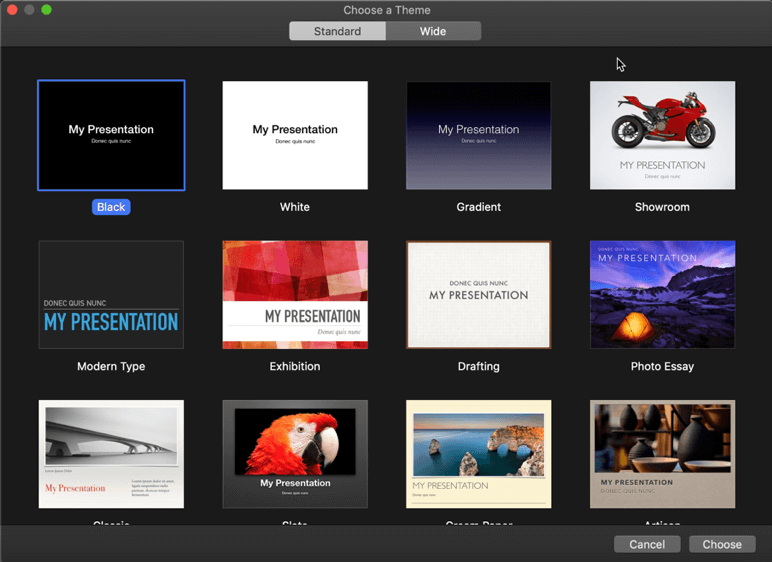
Note : If you don’t see the theme chooser above, press the Option key on your keyboard and click File > New to open a new Keynote file. The theme chooser will then appear on your screen.
Navigating the Keynote workspace isn’t as hard as it looks. The interface is relatively cleaner and simpler than PowerPoint. This is what the Toolbar looks like:
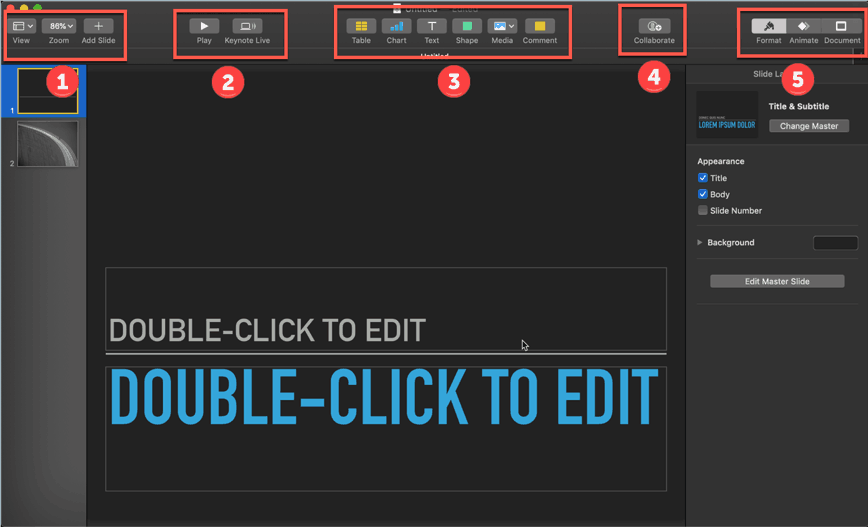
As you can see above, I’ve divided the Toolbar into 5 different parts. Here’s a run-down of what each part does:
1 – This is the navigation panel. As you can see, there are 3 buttons in this section (View, Zoom, and Add Slide):
- Under View , you can decide whether you want to use the Navigator view (default), Slide Only view, Light Table view, or Outline view. This is also where you go to edit the Master Slides, show object list, and more.
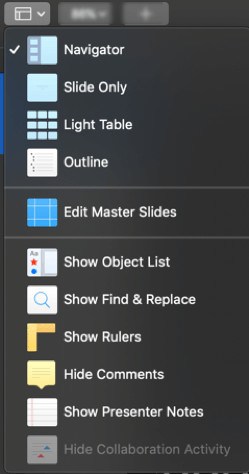
- You can also Zoom in or out of whatever view you’ve selected. If you don’t want to mess around with the percentages, you can always click on Fit Slide .
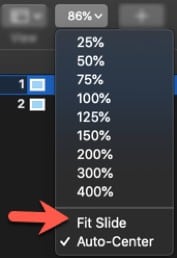
- Lastly, you can click on the Add Slide button to, well, obviously, add a slide. However, this is where it gets interesting. When you add a slide, Keynote doesn’t automatically add a blank slide (like PowerPoint). Instead, you get to choose the slide layout you want to use.
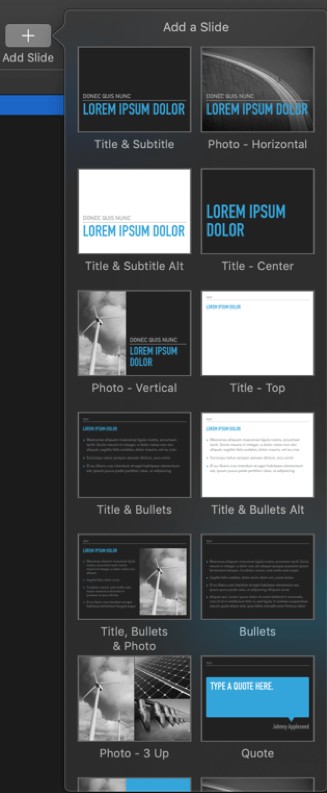
2 – This section consists of the Play and Keynote Live buttons.
- Clicking on the Play button will play your slideshow.
- Hit Keynote Live if you want to present a live slideshow to anyone in the world. Your audience can watch your presentation on any Apple or iOS device, or any browser connected to the Internet.

Note you’ll need to be connected to iCloud for this feature to work. Once you’re logged in, you can copy and paste the link to your slideshow and send it to your audience. You can also lock your presentation with a password if you’re concerned about security.
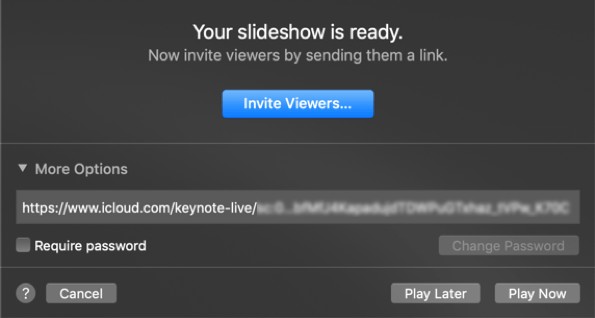
3 – In this section, you can choose from 6 different elements you can add to your slides. You can add a table , chart , text , shape , media (images, videos, audio) and comment . The first 5 elements are largely self-explanatory.
For the 6 th element (comments), these are helpful if you’re collaborating with somebody else. You can have a chat in real-time about your ideas and any changes you want to make to the design. In case you’re wondering, the comments won’t appear in your actual presentation.
4 – If you’re collaborating with other people, then you simply need to click the Collaborate button. You can specify who can access your Keynote and their permission level. Here’s what it looks like:

5 – The fifth section is where you go to edit the properties of all the elements and slides in your presentation. You can see 3 options or buttons here: Format , Animate and Document .
- Format. To format your slide itself, click on a blank space on your slide. You’ll be able to change your slide layout here as well as edit the Master Slide. You can also change the appearance of your slide (change background appearance, etc.).
- Format an element . The format menu options will change according to the element you click on. Say, for instance, you click on a text, then the formatting options for text will appear on your screen. If you click on a photo, then the image formatting options will appear, and so on.
- Animate (Slide Transition) . If you want to add animations when you transition from one slide to another, this is the correct button to click. Slide transitions are categorized into four: (1) Appear & Move, (2) Flip, Spin & Scale, (3) Object Effects, and (4) Text Effects. You can adjust the duration, color, delay, and more, of your selected effect.
- Animate (Element Effect) . You can choose to add a Build In effect, an Action effect, and a Build Out effect for your elements.
- Document . Click on this button to change your document settings. In here, you can adjust your Slideshow Settings, Presentation Type, Slide Size and more. Additionally, you can also record your slideshow in the Audio tab and add a Soundtrack . This is great if you plan on playing your slideshow in conference kiosks (self-playing) or converting your Keynote to video.

Additional Keynote options
You’re probably wondering if that’s all that Keynote can do. Well, of course not! In addition to the Toolbar, you can also access more settings and features in the Menu bar. You’ll see this at the very top of your screen:
If you think the default Toolbar lacks some important feature, and you don’t want to go looking for it in the Menu bar every time you want to use it, then you may want to customize the toolbar.
Here’s how you do it:
Go to View > Customize Toolbar . You can drag and drop your most frequently used buttons to the toolbar. For example, if you find yourself frequently using the Group and Ungroup options, then you may want to drag it into your toolbar so you can group/ungroup elements with just a single click. If you’re very particular about the size of your fonts, then add the Bigger and Smaller buttons to your toolbar.
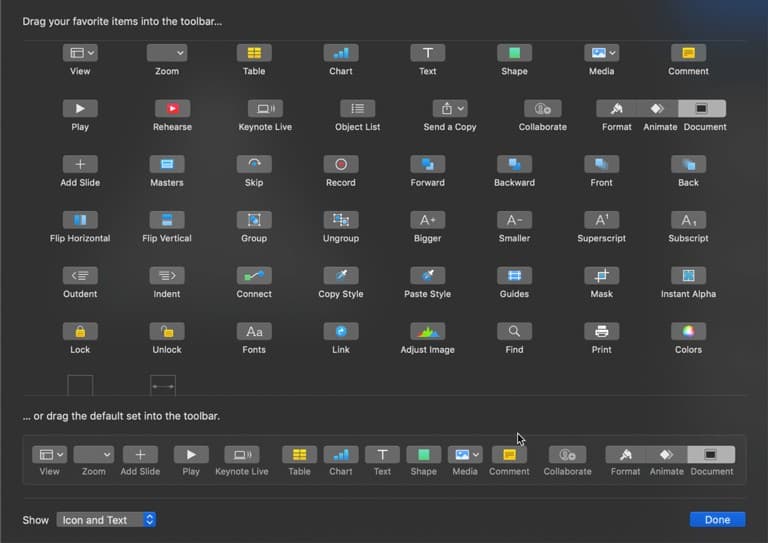
The good thing about customizing your toolbar is that you can always go back to the default settings. If you find yourself wanting to go back to the original toolbar menu, then go back into the Customize Toolbar menu again.
As you can see on the screenshot above, there’s an option to drag the default set into the toolbar . Don’t forget to hit the blue Done button when you’re finished.
Using iCloud Keynote
If you want the ability to edit your Keynote presentation on other devices, then log in to iCloud on your Mac. Go into System Preferences and click on iCloud . You’ll see this on your screen:
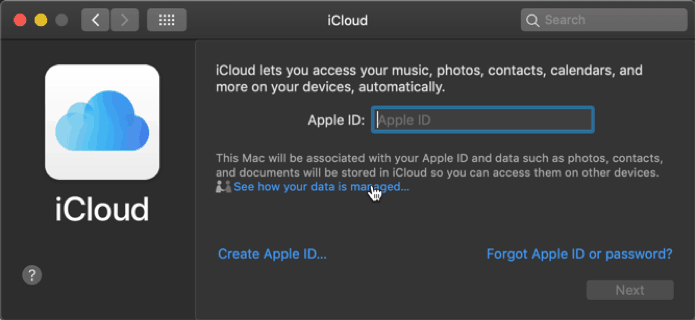
Type in your Apple ID and password if you already have one. If not, click on Create Apple ID .
Now that your Mac is logged in to iCloud, all your photos, contacts and documents (including Keynote files) will be stored in iCloud. This means if you have an iPhone or iPad, and you’re logged in using the same Apple ID, then all the files uploaded to iCloud will automatically appear in your Apple devices. So, you can create your Keynote on your MacBook or iMac, and then continue editing on your iPad or iPhone. Awesome, right?
But what about if you need to need to make last-minute changes to your presentation and you don’t have an Apple device nearby? Will all your hard work go to waste? Thankfully, not.
Just open a web browser on any computer and go to https://icloud.com . You’ll see this prompt on your screen:
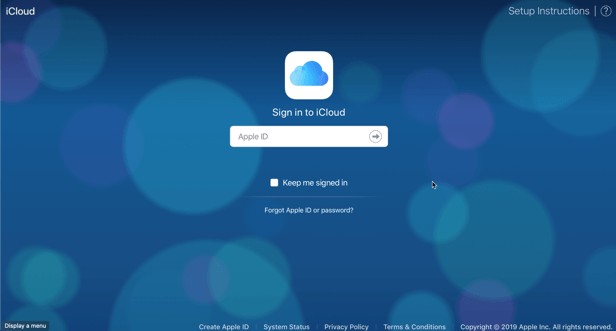
Once you’re logged in to iCloud, you’ll see this menu on your screen:
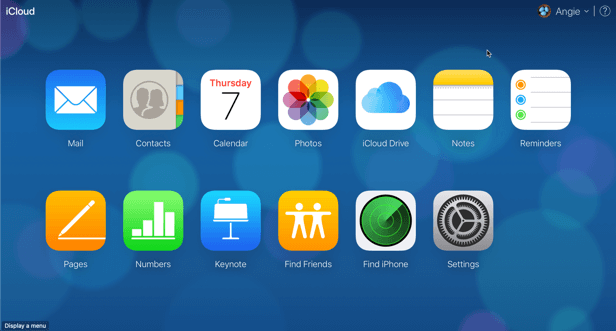
Click on Keynote and you’ll be able to see all the Keynote files you’ve made on other iCloud-linked devices. If you want to create a new file, click on Create Presentation .
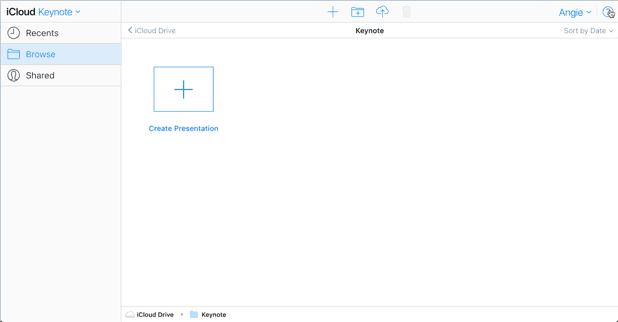
Just like in the desktop version of Keynote, you’ll see the Theme Chooser menu on your screen:
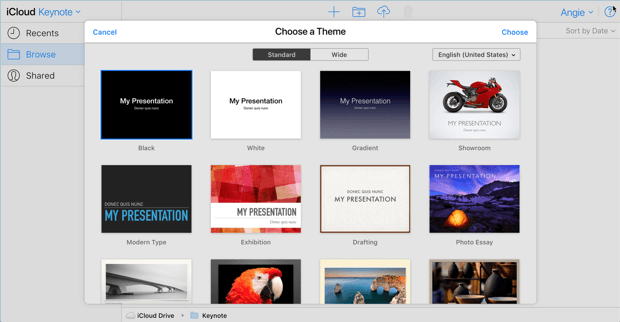
Click on the theme you want to use. A new tab will automatically open on your browser. This what the iCloud Keynote workspace looks like:
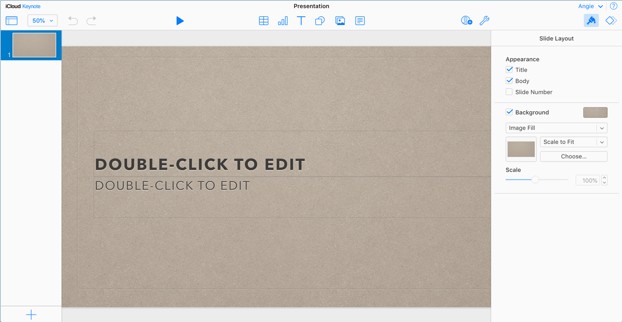
As you can see, it looks almost exactly the same as the desktop version. You’ve got the View and Zoom icons, the Play slideshow button, the 6 element types you can add to your slides (table, chart, text, shape, media, comment), the collaborate icon, and the format and animate button.
At a quick glance, however, you can see that the Keynote Live and Document icons are missing on the toolbar. Unfortunately, like most web-based presentation software, iCloud Keynote also has its drawbacks. A number of features from the desktop app are missing.
For instance, once you’ve selected your theme on iCloud Keynote, you’re going to have to stick with it. You simply don’t have the option to change it to another theme.
For this example, I used the Artisan theme in the screenshot above. I wanted to change it to the Gradient theme, but iCloud Keynote doesn’t have the Document button (available on the desktop version) that allows you to change themes and slide sizes.
There’s also no option to edit the Master Slides. While there’s a Media button, you’re limited to adding images only. This means inserting videos and audio files are not going to be possible on iCloud Keynote. Formatting options are also limited, so keep this in mind when creating and editing slides on the web.
The good news, however, is that iCloud integration is fantastic. You can create your slides in iCloud Keynote. Once you get your hands on an Apple computer, you can just edit your file on the desktop app. iCloud Keynote is great for editing presentations while you’re on the go. For maximum control, however, Keynote desktop is the way to go.
Tips to Make Your First Keynote Presentation a Standout
Even the most novice of Keynote users can make something stunning in just a few minutes. How? Well, if you haven’t noticed, Keynote’s built-in themes already look great. So, really, if you’re in a hurry, you can just choose one of the themes from the Theme Chooser. Then, select the layouts you want to use and replace the placeholders with your own content!
But, of course, if you truly want to make your keynote presentation a standout, then it’s best to actually put some time and effort into making one that your audience is going to love. So, here are some tips you can use to impress your audience and make sure your message is heard loud and clear.
- Keep text to a minimum
No matter what presentation software you use, it’s best to keep text to a minimum. You don’t want to copy and paste several sentences or a few paragraphs in your slides. You don’t want your audience to just read your slides. If you do this, then there’s really no incentive for them to listen anymore, is there?
As the popular saying goes, “less is more.” Strive to have a simple presentation instead of going for all the bells and whistles you can think of. Your audience isn’t there to read, they’re there to listen to your presentation.
Think of your slides as mere visual aids. They’re there to make your presentation more interesting. They’re supposed to help your audience understand your main points.
- Use the right font
Different fonts convey different emotions. There are fonts that look professional. Then there are those that look fun. There are even retro fonts and scary-looking fonts (perfect for Halloween-themed presentations).
Adding new fonts to your Keynote presentation is relatively quick and easy. You’ve got two ways:
- You can download a font package and add it to Font Book . You can look for this app in your Applications folder or you can search for it using Spotlight (press both Command + Spacebar ). Click the (+) icon in Font Book and locate where you saved the downloaded font. Your new font will now appear in the Font dropdown in Keynote.
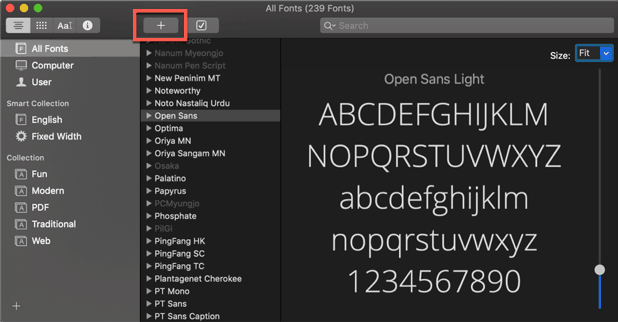
- The second option is to download an app called SkyFonts . You can download and install fonts from Google Fonts, Fonts.com, Monotype and MyFonts. Personally, I prefer this option because you don’t need to download the fonts to your computer. These are stored in the cloud and you can easily remove the fonts you’re no longer using.

Just a word of caution though. If you intend to download fancy fonts and use different devices to edit your Keynote slides, then you may be in for a shock. The fonts in iCloud Keynote are predefined, so whatever font you install on your Mac isn’t going to appear in iCloud Keynote.
- Use high-quality graphics
As the old cliché goes, a picture is worth a thousand words. You can put a picture on a slide, and it will tell the audience its own story. All without you needing to say a single word about it. That’s how powerful images are.
So, one of the first things you need to do once you figure out what you’re going to say in your presentation is to look for an image that will perfectly capture your main points. It doesn’t have to be an original photo or one that you took yourself.
You can use photos as background for your slides or you can use it as the main subject. The good news is there are millions of free images on the web. You just need to know where to look. Places like Unsplash , StockSnap and ISO Republic all offer high-quality images for free.
- Utilize white space
A busy-looking slide will only distract your audience. They won’t know exactly where to look. But if you have plenty of white space on your slides, then you can direct their attention to whatever you’re showing on screen.
Contrary to popular belief, white space doesn’t actually need to be white. It can be any color that will fit in well with your theme. For instance, take a look at the screenshot below. There’s a lot of blank space on the slide – this is what’s known as white space.

As you can see, it’s easy to follow what the slide above is trying to say. Doodling helps stimulates the brain, helps to see the big picture, improves learning, and helps to organize knowledge. The graphics used are simple enough to understand.
- Use third-party themes and templates
There’s obviously nothing wrong with using the built-in themes and templates on Keynote. But, if you want to stand out from the crowd of similar-looking presentations, then it’s best to use something else that not a lot of people are using. This is where third-party themes and templates come in.
You can download themes and templates that are made specifically for Keynote . Or you can use those that are made for PowerPoint! Surprised? Yes, PowerPoint templates do work on Keynote!
How To Use PowerPoint Templates For Your Keynote Presentations
To use PPT templates for Keynote, all you have to do is fire up Keynote, click on Open, then look for the PowerPoint file. If there are compatibility issues, Keynote will give you a list of things that may look different.
For this example, I downloaded one of our free templates, the Competitor PowerPoint Template pack. Note that you need to create a free account so you can download any of our templates.

Most PPT templates when opened in Keynote will probably have a few issues. I saw a couple of slides which needed a bit of editing. Here’s an example:

For the most part, however, the majority of slides looked great on Keynote! Here’s a screenshot of slides 5-10:
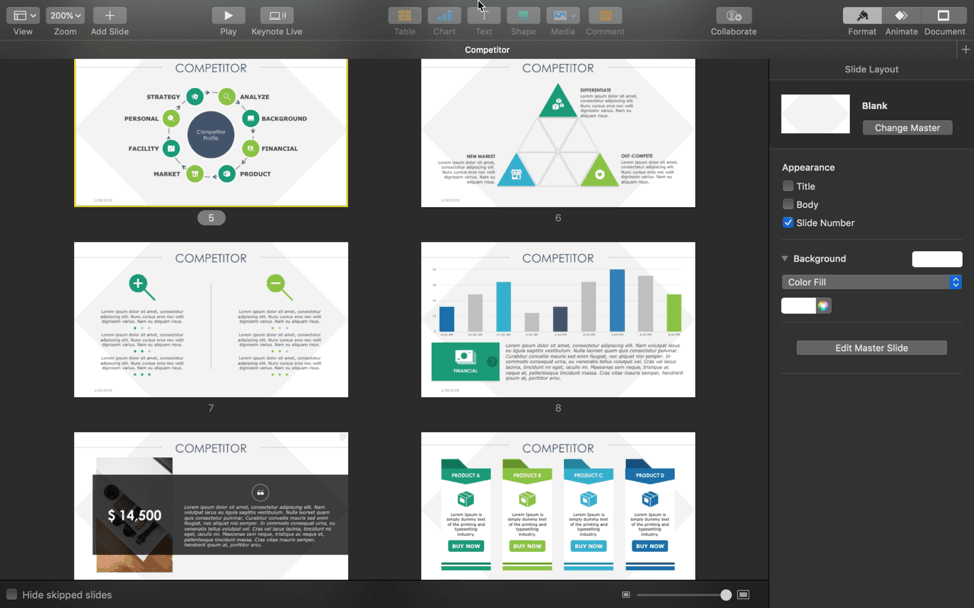
As you can see, the slides look really good. All you need to do is just edit and replace the placeholder content with your own, and you’re good to go! You can then save the file as a Keynote presentation or export it to another format.
Final Words
Apple users, rejoice! You’ve got a free and very capable presentation software on your hands. You don’t need to spend extra cash just to use PowerPoint. As you’ve learned in this article, Keynote is relatively easy to use. You’ll be able to create your first Keynote presentation in no time at all!
You might also find this interesting: PowerPoint vs Keynote: Which Is The Best Presentation Software?
Create professional presentations online
Other people also read

PowerPoint vs Keynote: Which Is The Best Presentation Software?

15 Popular PowerPoint Alternatives (Full Comparison Guide)

¿Cómo contratar y retener a un diseñador de presentaciones? ...

Genuine software, legally FREE - no cracking required!
Edit Word, Excel, and PPT effortlessly
Read, edit, and convert PDFs with the powerful PDF toolkit.
Microsoft-like interface, easy to use.
Windows • MacOS • Linux • iOS • Android

- Articles of Office solution
How to Add Presenter Notes to Keynote Presentations Easily?
Keynote is a fantastic presentation software available for Mac users. You can also add presenter notes with each slide. These notes assist you in delivering your presentation in more detail and effectively engaging the audience.
Sometimes, users need help adding notes while preparing their presentations. How do I add detailed presenter notes in Keynote? This guide will help you learn how to add presenter notes to Keynote presentations.
How to Use Presenter Notes in Keynote Presentations?
Making a presentation in Keynote is easy. You can design and create impressive presentations in Keynote. However, you can add bulleted points in the slides and can not add details in the slides. Presenter notes help you to add details with each slide. These notes allow the Presenter to deliver the presentation more effectively. You can add presenter notes to Keynote Presentations using the following steps.
Step 1: Open your presentation in Keynote or create a new presentation.
Step 2: Click the View option from the toolbar menu.
Step 3: You can also select the View option from Main Menu at the top.
Step 4: Select Show Presenter Notes in the view menu.
Step 5: Add your notes in the designated area.
Step 6: If you want to apply text formatting, you can use the Format Sidebar. If you do not see this option, click the icon highlighted in the picture below.
Step 7: If you want to hide the presenter notes, click the View option and click the Hide Presenter Notes option.

How to Present Keynote with Presenter Notes while doing your Presentation?
If you have two monitors, you can also show or hide presenter notes while presenting your presentation. Only you can see the presenter's notes on your screen. Your audience will not see these notes. Follow these steps to show or hide presenter notes while doing your presentation.
Step 1: Open your presentation with Keynote.
Step 2: Click the Play button from the toolbar menu.
Step 3: Click the icon highlighted in the following picture.
Step 4: Select Presenter Notes.
Step 5 : You can navigate through your presentation by pressing the right or left arrow or the spacebar on your keyboard.
Best Alternative to Keynote - WPS Office
You can only use Keynote on Mac and iOS devices. You may face compatibility issues if you want to open Keynote presentations on Windows, Linux, and Android devices. WPS Office is the best alternative to Keynote. You can create and design Keynote presentations using WPS Office. WPS Office is available for Windows, Mac, Linux, Android, and iOS devices.
Overview of WPS Office
WPS Office is a modernized and powerful office solution. It is available for free use. It is a rich-featured office productivity solution that includes all the features and options of Microsoft Office, Keynote, etc. WPS Office is an all-in-one office suite. It contains the following applications to fulfill user needs.
Presentation
Spreadsheet
WPS Office is becoming popular nowadays due to its different unique features. It is widely used by millions of people worldwide.
Advantages of WPS Office Over Keynote
WPS Presentation software is better than Keynote in many aspects. Following are some of the advantages of WPS Office.
Pro & Beautiful Templates
WPS Office includes different professional and beautiful templates. These templates help you to create professional-looking presentations conveniently. You can easily design and style your presentations using these templates.
Multi-Platform Compatibility
WPS Office is compatible with multiple platforms. You can use WPS Office on Windows, Mac, iOS, Android, and Linux users. In contrast, Keynote is only available for Mac users. You can not use Keynote on other platforms.
WPS 365 - Free Web Version
WPS Office is also available as a web version, called WPS 365. There is no need to download and install WPS Office your device. You can simply open any browser, e.g., Google Chrome or Microsoft Edge, and type in the WPS 365 URL. WPS 365 offers Docs, Sheets, Slides, AirPage, and Forms in the web version. All your data will be automatically synced with WPS Cloud. You can also collaborate with friends using the Teams option in WPS 365.
Easy To Use For Everyone
WPS Office has a user-friendly and intuitive interface. All options and features are easily accessible to everyone. New users can easily use WPS Office. However, Naive users may feel hesitation while using Keynote because Keynote is not a well-known and widely used software.
Fully Compatible with the New macOS Features
The Mac version of WPS Office is fully compatible with all the new macOS features. It supports Widgets, Sidecar, and Split Screen View. These new features enhance user experience and productivity.
Compatibility with all types of macOS systems
WPS Office is compatible with all versions of Mac operating systems. You can use WPS Office on macOS v13 Ventura, v12 Monterey, v11 Big Sur, etc.
Files Management Across Devices
With WPS Office, you can easily manage your files across multiple devices. All the documents are automatically synchronized with WPS Cloud. You can also integrate a cloud storage platform of your choice. You can access all your files on Mac, iPad, iMac, or iPhone.
A Free Alternative to Apple's Pages
Pages is a powerful Word processor for Mac devices. WPS Office is a free alternative to Apple Pages. You can easily create stunning documents using WPS Office Writer. WPS Writer includes all the features and functions of Pages.
How to Add Presenter Notes in WPS Office?
You can add presenter notes to your presentation using WPS Office. To add presenter notes to your presentation, click the Click to add notes option under any slide and start writing your notes.
How To Download WPS Office on Mac?
WPS Office is free to use on Mac and iOS devices. You can easily download WPS Office on your Mac devices by visiting the official website of WPS Office. Click the Free Download button to get your free version of the powerful WPS Office suite.
Frequently Asked Questions (FAQs)
1. can i use presenter notes for impromptu speeches.
No, it is not feasible to use presenter notes in impromptu speeches. Presenter notes are written in the planned presentation, where you have already prepared and added the notes. Impromptu speeches are delivered without prior preparation and planning. Adding presenter notes to these speeches is not recommended.
2. How can I avoid sounding robotic when using scripted notes?
Using these steps, you can read the scripted notes in a natural tone.
Use short sentences and avoid complex words
Smile while speaking
Use a good quality microphone
Use hand gestures while speaking to engage the audience
Make a pause where necessary
3. How to see/hide presenter notes in Keynote?
You can show or hide the presenter notes in Keynote in simple steps. To show the presenter notes in your Keynote presentation, select the View option and select Show Presenter Notes. Again, go to the View option to hide the presenter notes and choose Hide Presenter Notes.
Keynote Presenter Notes On Mac/iPad - Final Thoughts
Presenter notes add details to your presentation, which help you to give your presentation more confidently. As discussed above, you can easily add presenter notes in your Keynote presentation using simple steps.
You can also use WPS Office to create impressive and stunning presentations. WPS Office also helps you to add presenter notes with each slide. You can download WPS Office for Mac from its official website for free.
- 1. Keynote Design Guide_ Workflow, Tips, And Free Keynote Templates
- 2. How to Use Teams Presenter Mode for PowerPoint Presentations
- 3. How to Use Keynote Presentations Online: A Comprehensive Guide
- 4. Top 5 Free Keynote Templates for Stunning Presentations
- 5. How to Use Keynote Presentations Online: A Comprehensive Guide
- 6. How to Add Presenter Notes in WPS Powerpoint for Teaching

15 years of office industry experience, tech lover and copywriter. Follow me for product reviews, comparisons, and recommendations for new apps and software.
How to Add Speaker Notes in Keynote?

Last Updated: Jun. 19, 2024 | FEATURED IN: Quick Tips
A smooth and polished presentation requires excellent slides and a clear script to keep your speech on track. That’s where speaker notes in Keynote come in handy. Speaker notes act as a behind-the-scenes cue to help reinforce your key messages. They allow the presenter to add notes and help remember the key points related to the slides. With just a few taps on your Mac, iPhone, or iPad, you can add handy notes to guide you through any presentation.
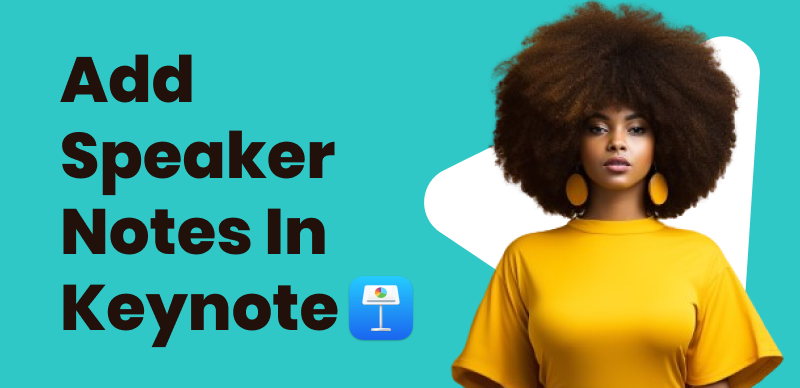
How to Add Speaker Notes in Keynote
But the real question is how to add speaker notes in Keynote . This article provides a step-by-step walkthrough on how to add speaker notes in Keynote across devices. You’ll learn how easy it is to create a presentation cheat sheet visible only to you. Let’s get into it.
ALso read:
How to Add and Work with Speaker Notes in Google Slides? >
How to Add Speaker Notes in PowerPoint >
Table of Contents: hide
Add presenter notes in the keynote on mac, add speaker notes in keynote on iphone, add speaker notes in the keynote on the ipad, bonus tip – how to add speaker notes on windows pc.
Adding speaker notes on Mac is a pretty simple process. Mac-based operating systems have their own Keynote application. With the help of the given steps, you can easily add notes on Mac:
Step 1 . Find the Keynote app and launch it on your Mac.
Step 2 . Find the presentation and open it in the application.
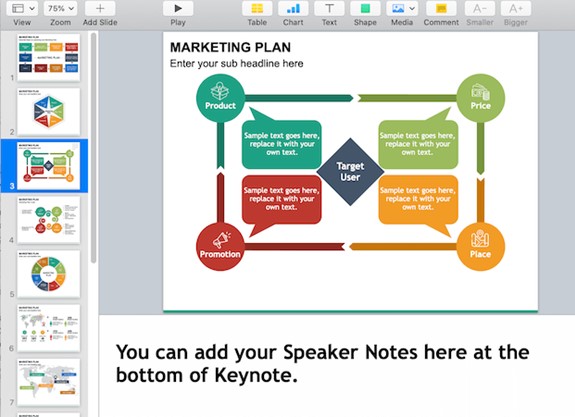
Open Keynote In Mac
Step 3 . Choose the “View” tab from the top of your screen. A drop-down menu will be opened.
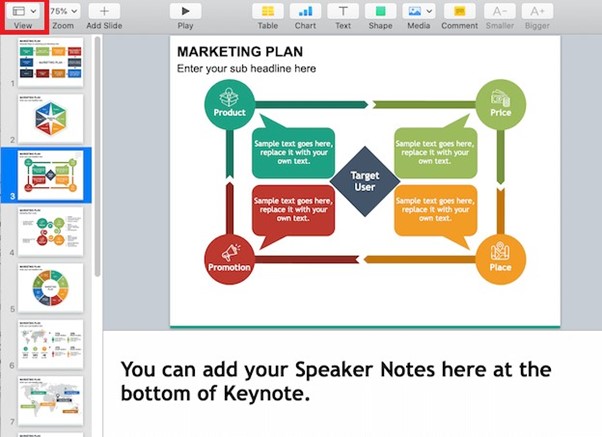
Click On the View Button
Step 4 . From the drop-down menu, click on “Show Presenter Notes.”
Step 5 . A white note-taking area will now appear beneath your slide.
Step 6 . Click into the white space and type any speaker notes, like talking points or a full script.
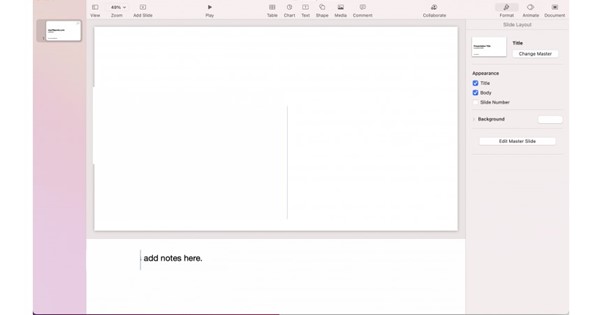
Add Notes In Keynote
Step 7 . When done, click “View” again and select “Hide Presenter Notes” to remove the notes pane.
The process of speaker notes in Keynote on an iPhone is similar to that of a Mac. All you need is the keynote mobile version for iPhone, and you are good to go. Follow these steps:
Step 1 . Launch the Keynote application on your iPhone.
Step 2 . Choose the slides in which you want to add notes.
Step 3 . A three-dot icon will be on the screen’s top left side. Press it to bring up more options.

Tap Three Dots In The App
Step 4 . Locate the “Show Presenter Notes” option and tap to enable it.
Step 5 . Press “Done” to apply changes. A new section with “Add Notes Here” will appear.
Step 6. Tap into the notes field and type out any speaker notes or prompts you want for that slide.
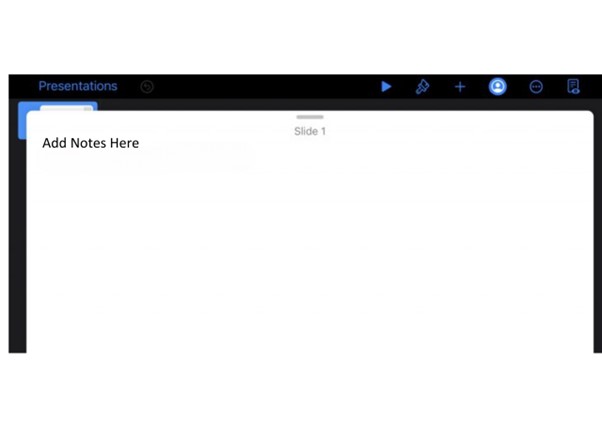
Add Notes In IPhone
Step 7 . Swipe up or down in the field to move between notes for different slides.
Step 8 . When finished, tap the three dots again, and this time, tap to turn off “Show Presenter Notes” to hide the notes.
Don’t have a MacBook or iPhone? No worries! Apple also includes a Keynote app for the iPad, which can come in handy to add speaker notes. Below are simple steps that can help you in this regard.
Step 1 . First, open your Keynote presentation and select the slide you want to annotate.
Step 2 . Tap the “Presenter Tools” icon in the top left corner to open the menu.

Open Presenter Tools on iPad
Step 3 . Next, turn on the “Show Presenter Notes” option in the Presenter Tools menu. This makes a notes field appear.
Step 4 . Tap into the notes field and type your prompts or script for that slide. Add notes for key talking points, statistics, reminders, and more.
Step 5 . When finished, return to the Presenter Tools menu and turn off “Show Presenter Notes” to hide the notes pane.
Pro tip : You can view the notes when showing your presentation using a connected display. Or turn on “Rehearse Slideshow” to see notes on the iPad.
Further Reading: How to Screen Record on iPad >
Need help to give flawless presentations or nail client calls? The new AI tool TalkEze has your back. This nifty tool helps you speak confidently and smoothly without filler words or awkward pauses. TalkEze works behind the scenes to guide you with invisible speaker notes so audiences only see a polished, commanding you. The best part about this tool is that it works seamlessly with any online meeting , live stream, or screen recording tool.
Talkeze offers a free trial (Free 3 days) plus paid monthly plans ($10-$13 per month) to fit every budget, and with Gemoo’s expertise in AI and natural language tech, you know it’s backed by speech science.
Key Features:
- The tools work well for the presenters who lack confidence due to poor narration.
- The invisible script feature ensures a natural flow and hides the notes from the audience.
- You can easily customize the scripts by adjusting the scroll speed, font sizes, and styles.
Wondering how speaker notes work with TalkEze? Let’s find out:
Step 1 . Download and Launch TalkEze on your PC. Sign in via Gemoo Account, Gmail or Apple ID to get started.
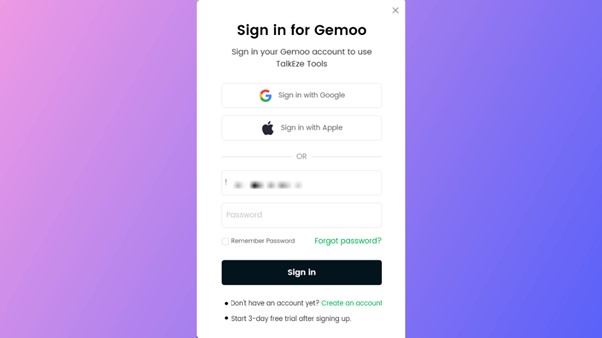
Sign In To TalkEze
Step 2 . After installation, set the preferences for your script. Adjust the font size and style, scroll speed, forward/rewind line space, and hide script in the final video.
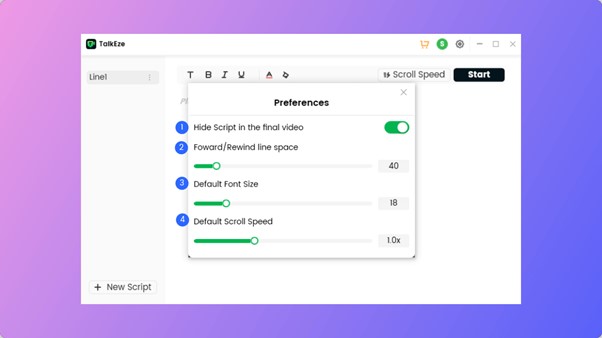
Preferences in TalkEze
Step 3. Y ou must input the speaker notes/script in TalkEze. Click on New Script and then choose from two options, i.e., Enter Script or Import .txt file.
Step 4 : Format your text or notes with the help of the tools above to make it more engaging. Moreover, you can adjust the scroll speed from the “Scroll Speed” button.
Step 5 . Click “Start” to initiate the process. The time elapsed will be displayed in the top left corner. Use the pause and play buttons at the bottom of the screen to control the presentation as needed.
You can utilize TalkEze to display the speaker notes during recording or live streaming your presentation with Keynote on your Mac, iPhone, or iPad.
Final Thought
Comprehensive speaker notes are a game-changer when presenting to an audience or speaking in an online meeting. You can add prompts in Keynote on Mac, iPhone, or iPad with just a few simple steps. Let notes guide you to smoother delivery and greater confidence. Start crafting your personal presentation cheat sheet today and take your public speaking skills to the next level with the power of speaker notes.
Let everyone enjoy a simplified workflow of video creating, editing, and sharing.
Keep Reading

Our API is officially out of beta — making Notion the hub for all tools
Elyse Greenblat
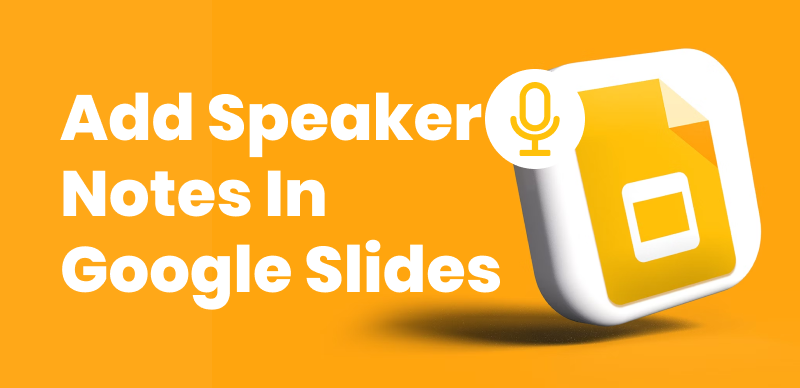
How to Add and Work with Speaker Notes in Google Slides?
How to Screen Record on a Mac without External Audio?

How to Fix Screen Recording Not Working Windows 10?
Pitching | Presentation | Public Speaking | Resources | Storytelling
15 pro tips to ace your keynote presentation.
Written by Shavinyaa Vijay

Keynote presentations can be terrifying for some of us. We fear messing up, looking bad on camera, forgetting our notes… The list of nightmares just doesn’t end.
While it’s not possible to have an entirely foolproof plan, we can minimize the number of ways where things can go wrong. So if you have an important keynote presentation coming up, here are some of our tips to help you out.
How to Ace Your Keynote Presentation
We’ll give you a concise guide on what you should be doing, from the time you start planning to the time you conclude your speech. Take these 15 quick tips and master them so you can deliver a stunning keynote presentation in no time!
1. Know Your Purpose
Before you start creating the layout of your slides or typing out the content of your speech, take some time to ask yourself — what is the purpose of your keynote presentation? What is the takeaway that you want the audience to have after your presentation? Essentially, you need to ask yourself, “What is my message?”. While it feels like time is ticking away, rushing into your slides will backfire in the long run. You need to ensure that the intention behind this presentation is clear and focused, as that would help you in creating a keynote presentation with clarity and confidence.
2. Be Confident
Ever heard of the phrase, ‘fake it till you make it’? Now’s a great time to take that advice! A significant factor in determining the success of your keynote presentation is your audience’s trust in you, and to gain their trust, you need to be confident in yourself first. Confidence in presentations comes from two sources: your posture, and your mastery of the content you are presenting. For posture, remember not to fidget and stand in a relaxed position. Stretch for a couple of minutes before presenting to loosen yourself up. As for your content, be sure to know the subject of your presentation like the back of your hand; read up as much as possible and do not start on it last minute.
3. Give Your Credentials
When introducing yourself, simply sharing your organization and position is not enough; if your audience wants to know where you’re from, all they need is a quick search online. What they do want to know however, is why you are the best person to deliver this presentation, and what you have to offer them. By sharing this, your audience will know that you’re knowledgeable in the field you’re presenting on, and that you have the solution to their needs or problems. Doing this will not only make your audience lean a little closer, but will also give you a great segue to move them into the next part of your presentation.
4. Deliver Your Hook
Research shows that the audience will stop listening to a presentation within 10 minutes if they are not persuaded that there is something in it for them. It is therefore important that you “hook” your audience by convincing them that they can benefit from your keynote presentation. You can do this by showing your audience that the key idea behind your presentation has the ability to make them feel happy or successful.
5. Introduce Your Agenda
At the start of your speech, be sure to let your audience know what the takeaway of your message is. Dedicate a slide to show your audience the agenda, and when presenting, remember not to read from the slides! Instead, offer a brief and general summary of your presentation. Give your audience the direction of your presentation, as this will allow them to follow your content better.
6. Ensure Smooth Transitions
Transitions are like sign posts that guide your audience throughout your speech, so they must be easy to follow, the last thing you need is a confused audience! Unclear transitions can be a nightmare as it may potentially distort the content of your presentation. In the end, the audience grasps only bits and pieces of your message, or worse, gives up on following your presentation. This applies not just to the visual effects that PowerPoint has, but also to the words you use. When transitioning from point to point, use words such as ‘next’, ‘then’, and ‘after’, and number your points using words like ‘firstly’, ‘secondly’, and ‘thirdly’. This will help the audience understand when you’re moving on to another idea or part of your presentation.
7. Give a Credible Statement
If you wish to gain your audience’s trust and establish a professional relationship with them, you need to get them to buy into your presentation. One way would be through giving credible statements that support your message. This can come in the form of data, or in the form of professional advice from experts in the field of your presentation. For example, make use of graphs and statistics to show the importance of a certain situation, and share quotes from someone with authority in a similar (if not the same) industry to backup your statements.
8. Use Images for Maximum Impact
The beauty of well-selected images lies in their ability to communicate a message without throwing dozens of words at an audience, so use them to your advantage! Select photos that encapsulate the message of your keynote presentation, or to highlight a specific idea that you’re sharing. Images that look simple can deliver the most powerful messages, and do what words sometimes cannot achieve — stir emotions in an audience. However, while images are a great tool, moderation is key. Stay away from photos that have been used too often (icebergs, anyone?), and use them sparingly throughout the presentation, as too many may reduce their impact.
9. Present data simply
Data is important in any credible presentation, and like we mentioned earlier, can help to establish your audience’s trust. However, it is crucial that the data be presented in a simple and uncomplicated manner. Too many numbers or graphs can be distracting for the audience, and may obscure the real intention of presenting the data. If you have large chunks of statistics, ask yourself: What is the key idea of the message you’re sharing? Which figures will back your statements up? From there, choose the appropriate data and highlight them accordingly.
10. One slide – one theme
Like transitions, each slide can be used as markers of the various points you aim to cover. Not only does this make your presentation easy for the audience to follow, it also makes it easy for you to remember your points as they are neatly categorised in each slide. It may seem tempting to squeeze all your information into few slides, but remember, moderation is key!
11. Be minimalistic
For a keynote presentation, simplicity is important when designing and organising your deck. You do not want the pattern or design to distract your audience from the real content and message. Again, it is also important that you do not overload the slides with words, so keep the sentences and points in your slides short. Let your speech expand on the ideas that you want the audience to take with them. Your communication and connection with them is more impactful in sending your message across than words on the slides.
12. Be consistent
Consistency is essential, especially when it comes to your presentation. Avoid using different backgrounds in every slide, and ensure that the design is reasonably similar throughout, unless you wish to use differences to distinguish individual points in your message. This makes the transitions in your presentation smooth, and thus it makes the story that you are telling easy for the audience to follow.
13. Practice, Practice, Practice
Rome was not build in a day, and similarly, a perfect presentation will not happen instantaneously! Rehearse your presentation a couple of times before the actual one, as this will help you in two ways. Firstly, you will gain familiarity with the content, which will definitely increase your confidence in delivering the presentation. Secondly, going through the deck aloud will allow you to listen to your speech from the audience’s perspective. This will aid you in tweaking and adjusting the content and structure of your presentation, to best fit the needs of the audience.
14. Analyse your audience
On the day of your presentation, analyse the audience. Get a general feel of the crowd. Are they excited? Are they bored? Are they tired? By doing this, you will be able to tweak the content of your presentation to fit the needs of your audience. If they are bored, you may wish to start with an interesting story related to your message. If they are tired, you could give them some time to get refreshed, either through a 5 minutes break or a quick activity to keep them alert. This way, you can ensure that you have a receptive audience ready to listen to what you have to say.
15. Q&A session
It is absolutely important that you leave some time at the end of your keynote presentation for a short “question and answer” session. Since the presentation was done from your perspective, the audience may have missed some important links and connections in your ideas. Therefore, a Q&A session is great in resolving any potential confusion that the audience may have.
There you have it, 15 simple tips to ace your keynote presentation! Just remember:
- Know Your Purpose
- Be Confident
- Give Your Credentials
- Deliver Your Hook
- Introduce Your Agenda
- Ensure Smooth Transitions
- Give a Credible Statement
- Use Images for Maximum Impact
- Present data simply
- One slide – one theme
- Be minimalistic
- Be consistent
- Practice, Practice, Practice
- Analyse your audience
- Q&A session
Now you’re good to go, all the best for your keynote presentation!
Article Written By: Shavinyaa Vijay
You may also like….

Val Yap: Delivering Success Through Effective Communication
by Kai Xin Koh
Success is not dictated by the hard work of one person alone. A great leader is also a great story-teller because effective communication is the foundation of any successful organisation.

Zia Zaman: How a World-Class Speaker brings Storytelling, Experimentation & Empathy into Business
Any businessperson understands the value of selling and the art of storytelling. They are indispensable and inevitable, yet only a few have truly...

Infographic Template Editor Site Review: Venngage
Introduction If you’re...
Sign Up for Winning With Stories!
- First Name *
- Email This field is for validation purposes and should be left unchanged.
- WordPress Tutorials
- Graphic Design
- Presentations
- Shopify Knowledge Base
- Theme Collections
Keynote Notes – Present Your Ideas Vividly
How to add presenter notes in keynote, how to use presenter notes in keynote.
- How to Show Presenter Notes in Keynote During Presentation
How to Print Keynote Notes
A long time ago, a well-known genius named Steve Jobs visualized his ideas with a special program. Apple took this program and redesigned it into Keynote. Now anyone can create spectacular and understandable presentations with this convenient and versatile tool. The Keynote app is not just a tool; it is Apple's combined experience in making and delivering presentations. Beautiful Keynote templates are powerful solutions to making an effective presentation with a few clicks. Having mastered the logic and mechanisms of successful presentations, you will be able to work with any application and understand how the final product can and should look. Today, we will talk about Keynote notes that help you present smoothly and efficiently.
Keynote notes are the notes added to Keynote presentation slides as reference material for the presenter. Notes on a Keynote slide are hidden from the audience during the presentation and are only visible to the person who is presenting the slides.
You can add Keynote presenter notes to your slides as a prompt so that your presentation runs smoothly and does not miss any important topic. When designing a presentation, you can make notes of the important key points that you want to cover, but that are not necessary for the audience to see.
Keynote presenter notes can include anything. For example:
- personal information
- technical specifications
- product information
- dates/events
So, how do you make notes in Keynote? Let’s get to the step-by-step guide and find out how to add and use Keynote speaker notes to get the most out of this feature.
Follow these simple steps to learn how to make notes in Keynote presentations on a Mac.
1. Open your presentation.
2. Navigate to the View menu on the top panel.
3. Choose “Show Presenter Notes” from the drop-down.
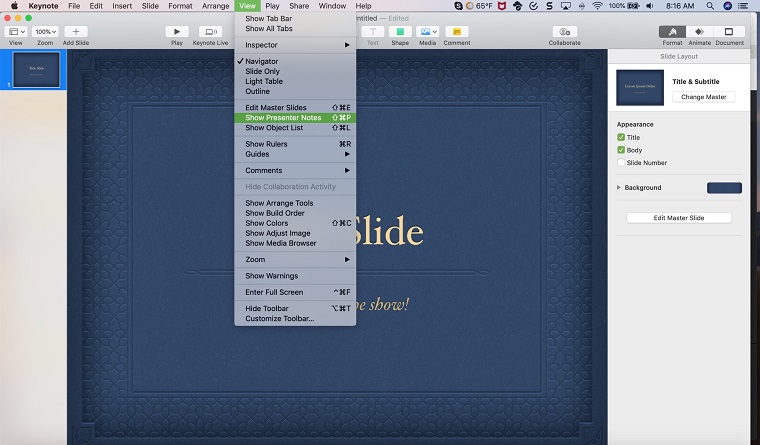
4. Make your note inside of the big white box that appears at the bottom.

In case you are working on a Keynote presentation on iPhone or any other iOS device, follow the steps below:
1. Open your Keynote presentation.
2. From the top right corner, click the three-dot icon (More button).
3. Enable “Show Presenter Notes” from there.

Whenever you are ready to present, go through the following steps to pull up the presenter Keynote notes on a Mac:
1. Go to the top right corner and click the Presenter Tools button.
2. Choose Presenter Notes.
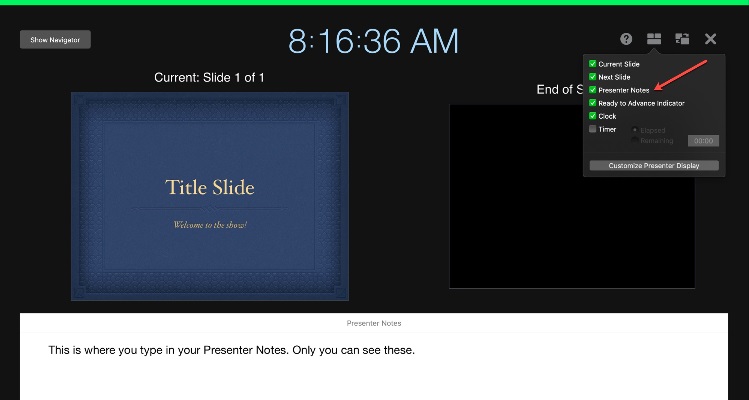
To enable Keynote notes on your iPhone or iPad, follow the steps below:
1. Click the Presenter Layout button on the top.
2. Choose Current and Notes if you want to see the notes on the current slide.
3. Choose Next and Notes if you want to see the notes on the next slide.
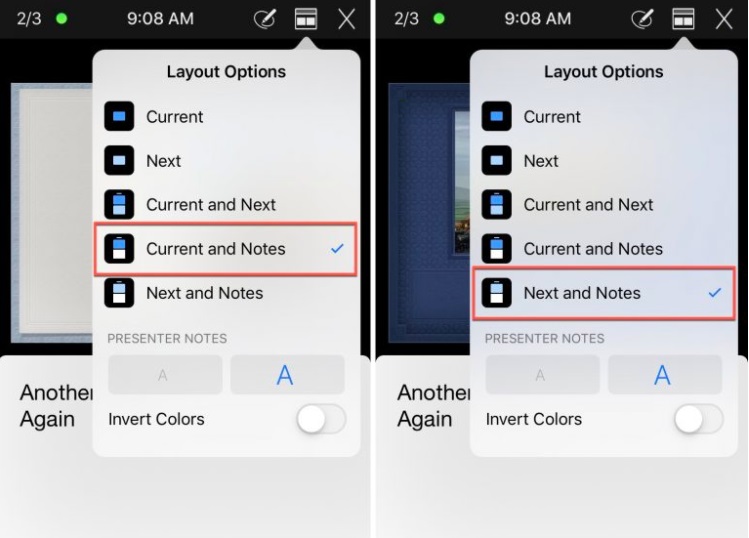
How to Show Presenter Notes in Keynote during a Presentation
You can view the speaker notes in Keynote on the screen while the presentation is displayed on the presenter display.
1. Click the Play Button on the Mac toolbar, then the Layout Button (choose which parameter tools to display).
If the Layout Button is not displayed, hover your cursor over any part of the speaker's screen.
Parameter tools to display include:
- Current Slide
- Presenter Notes
- Timer (elapsed or remaining)
2. Select the Presenter Notes checkbox and click outside the dialog box to close it.
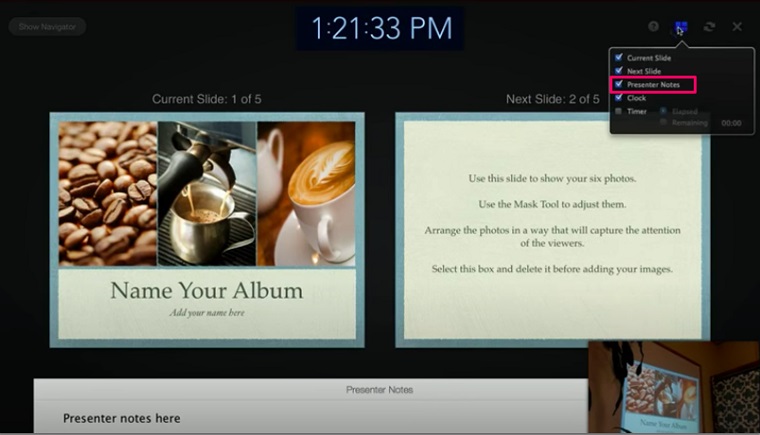
To change the appearance of the presenter notes, do one of the following:
- Change the font size . Hover over the speaker's notes window, then click one of the font buttons to decrease or increase the font size.
- Invert text and background colors. Hover over the presenter notes window, then click the Invert colors button to display white text on a black background or vice versa (other colors will not change).
To add or edit the notes in Keynote while playing a presentation, hover your cursor over the Keynote presenter notes window, and then click the Edit button.
Of course, overall, the term "presentation" is stereotypically associated with an event at which the speaker makes a speech, using a presentation file prepared in a presentation program as illustrative and explanatory material. This allows the public to get the information you want to convey to them. It would be good to accompany your speech with the distribution of illustrative material. In this case, you will need to print out the necessary information contained in the presentation file and distribute it to the guests at your event.
To print the content from your presentation, you will need to follow the steps below:
1. Go to the File menu > Print.
2. Once the print window appears, you can select the format, slide layout, and options.
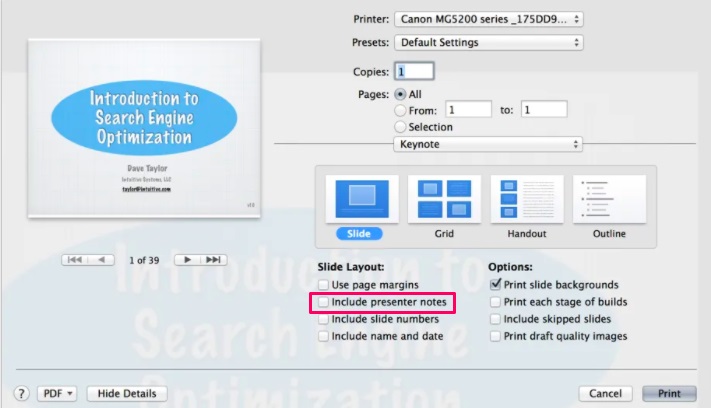
3. Click the Print button to send the request to your printer.
This has been a step-by-step guide on how to add and use Keynote speaker notes. As you can see, it is extremely easy to work with the notes in Keynote to make your presentation as effective as possible. They allow you to expand the details of Keynote slides, simplifying them in the process. Use the speaker notes in Keynote to view and print the notes with just a few clicks.
Absolutely not. That is an optional and very helpful feature, which allows you to add small tips and comments to the slides to make sure the presentation runs smoothly and that you do not miss any important details.
1. Change the notes to your linking in one slide. 2. In the Format pane on the right, make sure that the paragraph style is set to "Presenter Notes.” 3. Click the blue "Update" button next to the presenter notes paragraph style. 4. It will change the presenter notes for the entire slideshow to that updated paragraph style.
To print a handout with multiple slides per page (and, optionally, with presenter's notes), click Handout. Click the Slides per Page pop-up menu to specify the number of slides that Keynote should print on each page.
While you can export the presentation through the File menu > Export, you should remember that Keynote does not have a feature for exporting only the presenter notes.
Free Keynote Templates with Modern Design 2020
50+ Keynote Templates to Create Professional Presentations in Minutes [Lots of Freebies of Premium Quality Inside]
Top 50 Keynote Templates
Google Slides vs PowerPoint vs Keynote: What Presentation Software to Choose?
A freelance copywriter, who has a great interest in writing, content-related stuff, traveling, and photography. She is always mastering her writing skills to synthesize the essence of any business ideology in an easy-to-use nugget of words to get people to feel, think, or respond. Instagram .
Get more to your email
Subscribe to our newsletter and access exclusive content and offers available only to MonsterPost subscribers.

Related Posts
21 easy tips to create a powerful presentation for your business [free ebook], best digital products award 2023 – honored by templatemonster, making a successful presentation: how to print google slides with notes.

Microsoft 365 Life Hacks > Presentations > How to add citations to your presentation
How to add citations to your presentation
When you craft a formal presentation, you often have to conduct research. Any books, journals, and other forms of media used should be properly cited for your personal reference as well as for your audience. Learn how to create citations in a presentation to appropriately credit different works.

Why should you provide citations?
Information referenced from another source must be clearly cited. Proper citations serve as a roadmap for research, help track ideas, and establish credibility. Citations give credit to the original works and provide transparency for readers and their audience regarding the source.
Readers can access your sources and develop a deeper understanding of your research. They can also explore research from your respective discipline or industry. Additionally, researchers utilize citations to align their work with established experts and bolster the validity of their claims. Without citations, audiences may assume your idea is original, resulting in plagiarism. Acknowledging the intellectual contributions of others with proper citation fosters academic integrity and supports the advancement of ideas amongst scholars and researchers.

Tell your story with captivating presentations
Powerpoint empowers you to develop well-designed content across all your devices
How to source citations in a presentations
To source citations effectively in presentations, consider the following:
- Identify your sources: Begin by identifying all the sources you have used in your research, including books, articles, websites, and any other relevant materials. Note the authors, publication dates, publisher, and other relevant information for citations.
- Include in-text citations: Incorporate in-text citations throughout your presentation slides to indicate when you are referencing external sources. This helps your audience understand the basis of your arguments and provides transparency regarding the origin of the information presented.
- Provide a reference list: At the end of your presentation, include a reference list that provides full bibliographic information for each source cited. This allows your audience to locate the original works for further reading and verification. Ensure your reference list adheres to the citation style used with your citations.
- Use visual aids: Consider using visual aids , such as infographics or posters , to display citations alongside the corresponding content. This helps reinforce the connection between the information presented and its original source.
Alternatively, you can also provide the references verbally throughout the presentation. This allows the audience to follow along with your presentation and directly reference sources as you present. If you are creating a presentation for a class, follow the instructions or preferences of your instructor. By doing so, you can ensure your citations are understood and appropriate for your audience.
Citations are a critical component of an effective presentation. Citations provide a roadmap for your research, credit the appropriate authors, and foster academic integrity. They’re easy to include in a presentation as in-text citations on your slides and as a reference list. Include citations to make sure you presentation credits the appropriate authors and strengthens its validity. For more help with preparing sources, research, and crafting presentations, learn more presentation tips .
Get started with Microsoft 365
It’s the Office you know, plus the tools to help you work better together, so you can get more done—anytime, anywhere.
Topics in this article
More articles like this one.

How to introduce yourself in a presentation
Gain your audience’s attention at the onset of a presentation. Craft an impressionable introduction to establish tone, presentation topic, and more.

How to work on a group presentation
Group presentations can go smoothly with these essential tips on how to deliver a compelling one.

How to create a sales presentation
Engage your audience and get them interested in your product with this guide to creating a sales presentation.

7 tips for creating and presenting a webinar

Everything you need to achieve more in less time
Get powerful productivity and security apps with Microsoft 365

Explore Other Categories
WWDC24 Highlights
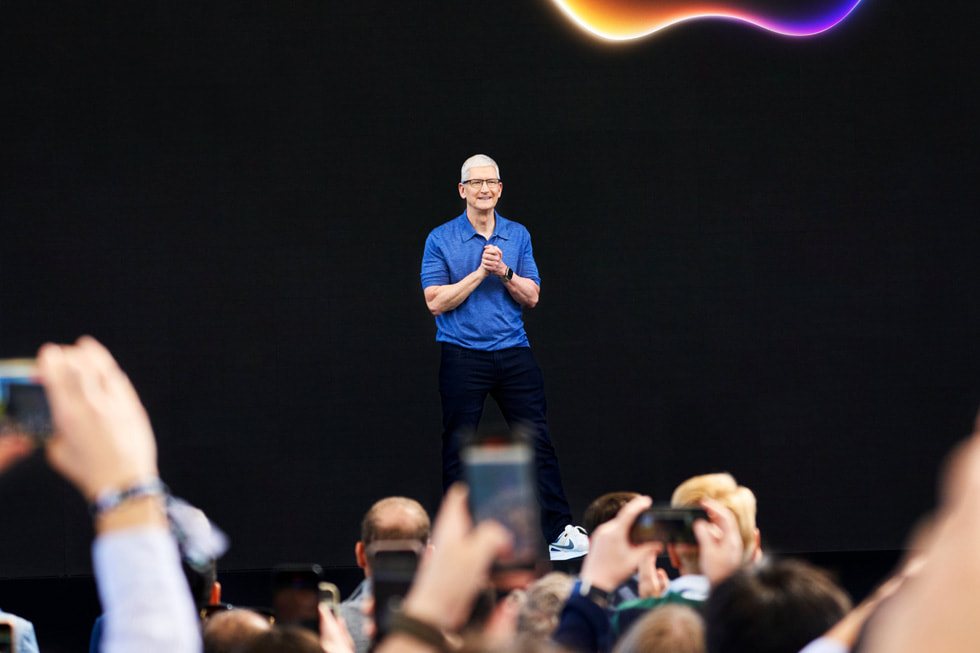
Apple Reveals Apple Intelligence
iOS 18 Makes iPhone More Personal and Intelligent Than Ever
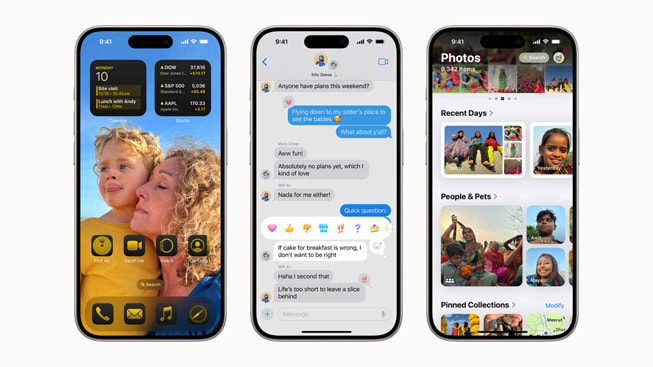
iPadOS 18 Takes iPad to the Next Level
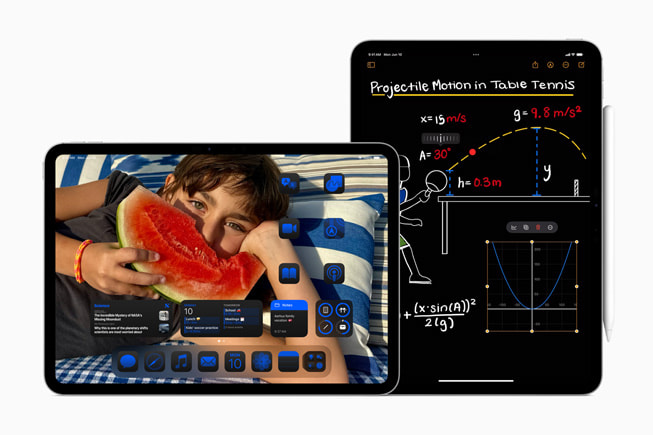
macOS Sequoia Brings New Ways of Working and Transformative Intelligence to Mac

watchOS 11 Offers Powerful Health and Fitness Insights, and More Personalization
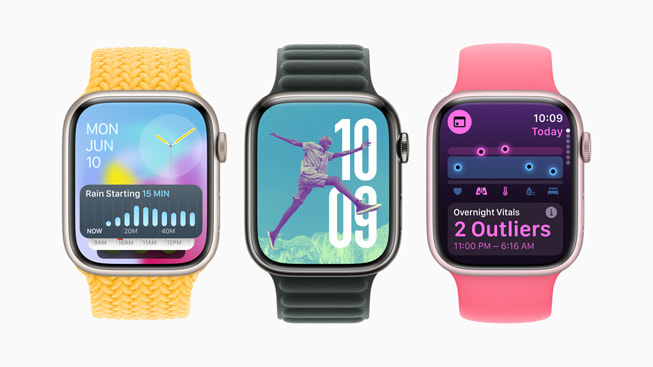
visionOS 2 Brings New Spatial Computing Experiences to Apple Vision Pro
Home and Audio Updates Elevate Entertainment and Bring More Convenience
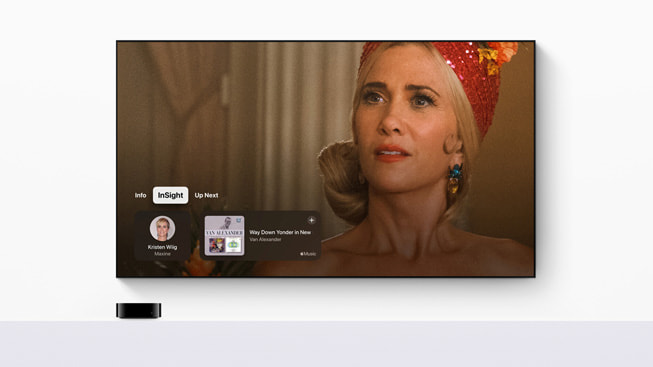
Text of this article
June 10, 2024
Relive the biggest moments from WWDC24
Today Apple kicked off its 2024 Worldwide Developers Conference, revealing groundbreaking new technologies and features during a keynote that was live-streamed from Apple Park to millions around the world. During the weeklong event, developers and students will have unique access to Apple experts, as well as insight into new tools, frameworks, and features to help elevate their apps and games.
This year’s keynote revealed Apple Intelligence , the personal intelligence system that combines the power of generative models with users’ personal context — at the core of iPhone, iPad, and Mac to deliver intelligence that’s incredibly useful and relevant. Major updates also come to iOS 18 , iPadOS 18 , macOS Sequoia , and watchOS 11 , including the biggest-ever redesign of the Photos app, game-changing productivity tools, and new ways for users to express themselves and customize their devices. visionOS 2 brings powerful new ways to interact with Apple Vision Pro and exciting updates to spatial photos and Mac Virtual Display, and tvOS 18 infuses useful information in Apple TV+ films and shows on users’ biggest screen in the home.
Beginning this month, Apple Vision Pro is also coming to more countries and regions, including China mainland, Hong Kong, Japan, Singapore, and next month will come to Australia, Canada, France, Germany, and the U.K.
Apple Intelligence harnesses the power of Apple silicon to understand and create language and images, take action across apps, and draw from users’ personal context to simplify and accelerate everyday tasks. A cornerstone of Apple Intelligence is on-device processing, which delivers personal intelligence without collecting users’ data. Private Cloud Compute sets a new standard for privacy in AI, with the ability to flex and scale computational capacity between on-device processing, and larger, server-based models that run on dedicated Apple silicon servers.
With iOS 18 , users will now be able to arrange apps and widgets in any open space on the Home Screen, customize the buttons at the bottom of the Lock Screen, and quickly access more controls in Control Center. With the biggest redesign ever of the Photos app, photo libraries are automatically organized in a new single view in Photos, and helpful new collections keep favorites easily accessible. All-new text effects come to iMessage, amplifying any letter, word, phrase, or emoji with dynamic, animated appearances to bring conversations to life. Users can also now communicate over satellite in the Messages app, even when a cellular or Wi-Fi connection isn’t available.
With iPadOS 18 , the iPad experience is more versatile and intelligent than ever with new features and apps designed for Apple Pencil. The Calculator app comes to iPad with Math Notes, which allows users to type or write out mathematical expressions and see them instantly solved in their own handwriting. New handwriting tools in Notes including Smart Script make handwritten notes more fluid, flexible, and easier to read.
With macOS Sequoia , Continuity between iPhone and Mac gets better than ever with iPhone Mirroring, enabling full access to and control of iPhone directly from Mac. Safari gets another big update with the new Highlights feature for effortless information discovery on webpages while browsing. Gaming is even more immersive with Personalized Spatial Audio that puts players in the middle of the action like never before. And Apple Intelligence unlocks new ways for Mac users to enhance their writing and communicate more effectively, create playful images in seconds, and more. Apple Intelligence takes full advantage of the power of Apple silicon and its Neural Engine, and will be supported by every Mac with an M-series chip.
watchOS 11 offers breakthrough insights into users’ health and fitness, and more personalization than ever. The new Vitals app surfaces key health metrics and context, the ability to measure training load offers a game-changing new experience when working out, and the popular Activity rings are even more customizable. The Smart Stack and Photos face use intelligence to feature more individualization, and Apple Watch and the Health app on iPhone and iPad offer additional support for users who are pregnant. Check In, the Translate app, and new capabilities for the double tap gesture come to Apple Watch for added connectivity and convenience.
Just months after its initial release, visionOS 2 brings powerful spatial computing experiences to Apple Vision Pro, including new ways for users to create spatial photos with the images already in their library, intuitive hand gestures to easily access important information at a glance, and new features for Mac Virtual Display, Travel Mode, and Guest User. visionOS 2 also introduces exciting new capabilities like Follow Your Breathing in the Mindfulness app, SharePlay for Photos, and multiview in the TV app.
With tvOS 18 , intelligent new features like InSight — and updates to Enhance Dialogue and subtitles — level up cinematic experiences, while new Apple Fitness+, Apple Music, and FaceTime capabilities get even better on users’ biggest screen. The Home app gains new features with iOS 18, like guest access and hands-free unlock with home keys, delivering effortless and secure access to the home. AirPods software updates will transform the way users respond to Siri with new gestures, take calls with friends and loved ones, and immerse themselves in their favorite games.
Press Contacts
Apple Media Helpline
Images in this article
Set up your presentation in Keynote
Learn how to choose a theme, add slides, and change the look and aspect ratio of your presentation on your iPhone, iPad, Mac, or online at iCloud.com.
iPhone or iPad
Use Keynote on iPhone or iPad
Learn how to choose a theme, add content, change the look of a slide, and more.
Choose a theme and add content
To create a Keynote presentation, first choose a theme. Themes contain predesigned slide layouts, which you can use as a starting point for your presentation.
Tap Choose a Theme, then tap a theme.
To add your own text, double-tap placeholder text.
Change the slide size
You can change the slide size to fit screens with different aspect ratios. Any existing content might be moved to accommodate the new aspect ratio.
Open your presentation in Keynote.
Tap Presentation Options, then tap Presentation Setup.
Tap Slide Size at the bottom of the window, tap a new size, then tap Done.
If you choose Custom, enter the slide dimensions, then tap Done.
Change the look of a slide
To quickly change the look of a slide, you can apply a different slide layout to it. When you change a slide's layout, any content you've already added appears in the new layout.
Select one or more slides.
Swipe to see all slide layouts, then tap one to apply it.
Change the look of your entire presentation
To quickly change the look of your entire presentation, you can choose a new theme at any time. If you added content, it's placed in the slides of the new theme. Any customizations you've made, like changing the color of text, appear in the new theme.
Tap Themes at the bottom of the window.
Tap a theme or swipe to see more themes.
When you're finished, tap Done.
Edit slide layouts
To quickly make changes to multiple slides in your presentation at once, you can edit slide layouts. You can change the layout of a slide, add text, images, and objects. Changes to slide layouts affect the slides in your presentation that use the same slide layout.
Tap on the background of a slide, then tap Edit Slide Layout in the menu that appears.
In the sidebar, tap a slide that you want to edit.
Choose what you want to do — rearrange content, add text, images, and objects.
When you’re done editing slide layouts, tap Done in the upper-right corner.
Use Keynote for Mac
In Keynote, choose File > New, then double-click the theme you want to use in the theme chooser. If the theme chooser doesn't appear, hold the Option key, choose File > New from Theme Chooser, then double-click the theme you want to use.
To add your own text, double-click placeholder text.
You can change the slide size to fit screens or projectors with different aspect ratios. Any existing content might be moved to accommodate the new aspect ratio.
Choose a slide size from the Slide Size pop-up menu.
If you chose Custom Slide Size, enter the slide dimensions, then click OK.
To change the look of your entire presentation, choose a new theme at any time. If you added content, it's placed in the slides of the new theme.
Click Change Theme.
Double-click a new theme.
To make sure the customizations that you've made (like text color) appear in the new theme, select “Keep your style changes.”
You can always undo a theme change if you preferred your previous theme.
To quickly make changes to multiple slides in your presentation at once, you can edit slide layouts.
From the menu bar, choose View > Edit Slide Layouts.
In the sidebar, select a slide layout that you want to edit.
When you’re done editing slide layouts, click Done in the lower-right corner.
Changes to slide layouts affect the slides in your presentation that use the same slide layout.
Keynote for iCloud
You can choose a theme when you create a new Keynote presentation online at iCloud.com.
Double-click a theme. The presentation opens in a new tab or window in your browser.
To add your own text to a slide, double-click the placeholder text.
To add your own image to a slide, drag an image from your computer to the placeholder image.
If you want to change the look of slides, slide size, or the theme after initially creating your presentation in Keynote for iCloud, open your presentation in Keynote on your iPhone, iPad, or Mac.

Related topics
Explore Apple Support Community
Find what’s been asked and answered by Apple customers.
Contact Apple Support
Need more help? Save time by starting your support request online and we'll connect you to an expert.
Georgetown Law
Student journals: 2024 symposia recap.
June 28, 2024

Panelists Chris Paiva, Brishen Rogers, Gabrielle Rejouis and Dominic Gardetto discuss automation, artificial intelligence and surveillance at the Georgetown Journal on Poverty Law and Policy Symposium.
There are a dozen student-run legal journals at Georgetown Law, each publishing original academic scholarship on themes ranging from deepfakes to medical malpractice settlements to prosecutorial reform. In addition to selecting and editing articles, comments and notes in every issue, most of the journals have an opportunity every other year to host a symposium, or conference, with panels and keynote speakers discussing topics relevant to the journal’s area of focus.
Planning an event like this is no small task, especially for full-time law students who also have jobs and externships. Journal symposium editors not only work with their fellow journal members to define a symposium theme and identify panelists who will contribute to stimulating discussions, they also have to handle logistical arrangements from registration systems to travel budgets to catering options. Despite the extra workload, however, most students who take on the assignment say they are glad they did so.
“Symposium development is a great example of how Georgetown Law provides its students opportunities to learn the skills we will need to make us well-rounded, competent professionals,” said Journal of National Security Law and Policy (JNSLP) Symposium Editor Caitlyn Johnson, L’24, who organized a symposium on election security in March.
The Future of Work: The Intersection of Poverty and Labor
On March 1, The Future of Work: The Intersection of Poverty and Labor Symposium, organized by The Georgetown Journal on Poverty Law and Policy (GJPLP) and co-sponsored by Georgetown Law’s Workers’ Rights Institute , Center on Poverty and Inequality and Center on Privacy and Technology , focused on child labor, unions and employment law.
In her presentation Labor and Employment Law as Poverty Law , Sejal Singh, U.S. Department of Labor Honors Attorney and co-founder of People’s Parity Project, a progressive legal reform organization, said, “Poverty is a policy choice. It is a policy choice shaped by, reflected in and entrenched by labor and employment law and policy…[It] has disempowered workers, our families, and our communities in favor of the bottom line.”
The panel, Resurgence of Unionism and the Changing Landscape of the NLRA, featured Visiting Professor Mark Gaston Pearce , Executive Director of the Workers’ Rights Institute; Craig Becker, Senior Counsel at AFL-CIO; and Brandon Magner, Field Attorney at the National Labor Relations Board (NLRB).

Students listen to panel discussions surrounding labor law.
Symposium Editor Joe Anderson, L ’24, said he enjoyed putting together a conversation from a variety of perspectives. “It was enriching to hear lawyers, on the ground workers, judges, historians, professors and government appointees exchange their viewpoints and flesh out a rich portrait of what labor in 2024 looks like.”
Editor-in-Chief of GJPLP Sierra Campbell, L ’24, was most excited to highlight all of the work being done at the intersection of labor and poverty law, adding, “Worker protections and pro-worker policies are critical to addressing economic and racial inequities.”
Click here to watch the panel discussions.
70 Years Later: Revisiting Brown v. Board of Education and the Struggle for Racial Equity in Education
70 Years Later: Revisiting Brown v. Board of Education and the Struggle for Racial Equity in Education , hosted March 7 by the Georgetown Journal of Law & Modern Critical Race Perspectives (MCRP) and co-sponsored by The Office of Journal Administration , Racial Justice Institute , Racial Equity in Education Law and Policy Clinic , Georgetown Asian Pacific American Law Students Association , Georgetown Black Law Students Association , Georgetown Latin American Law Students Association and Georgetown American Constitution Society , used the anniversary of a landmark Supreme Court decision on public school desegregation to focus on the history of segregation, school discipline and racial equity in education.
Rebecca Epstein , Executive Director of the Georgetown Center on Gender Justice & Opportunity , moderated the panel Examination of School Discipline and Exclusionary Practices . The panelists included Noelia Rivera-Calderón, Staff Attorney for the Advancement Project; Thalia González, Professor of Law and Co-Director at the Center for Racial & Economic Justice at UC Law San Francisco; and Paige Joki, Staff Attorney at the Education Law Center.
Senior Symposium Editor Chelsea Clayton, L ’24, reflected on her time at Georgetown Law and how proud she is of the work being done through the MCRP Journal.

Professor Janel George, Director of the Racial Equity in Education Law and Policy Clinic, spoke on the panel Affirmative Action in Higher Education.
Clayton said, “ Planning this symposium was a remarkable culmination of my three years at Georgetown, allowing me to incorporate all the knowledge and experiences I have gained during this time.”
Clayton, a Research Assistant for Georgetown Law’s Racial Equity in Education Law and Policy Clinic , highlighted how the MCRP Symposium can help students find their area of interest.
“Throughout my time in law school, I have been on the journey of learning all the potential career options in the area of education law, and planning the symposium provided me the opportunity to work with practitioners who do a variety of work within the area.”
Click here to see the full agenda.
Election Integrity as a National Security Imperative: Current and Future Challenges to Securing American Elections
Election Integrity as a National Security Imperative: Current and Future Challenges to Securing American Elections, organized by the Journal of National Security Law and Policy (JNSLP) and co-sponsored by Georgetown Law’s Center on National Security , highlighted lessons learned from the 2020 election and securing future elections.
The panel, Careers in National Security Law: The Intersection of Policy, Politics and Practice , included: Todd Huntley , Georgetown Law Professor; Sabrina McCubbin, Department of Defense Attorney; and Susan Kovarovics, an International Trade Partner at Akin.
Senator Amy Klobuchar (D-Minn.) gave the keynote address via video. “We are living in a time in our country and our world where the fractures in democracy and the rule of law are being laid bare — when political rhetoric has become more and more divisive, when the husband of the former Speaker of the House of Representatives is bludgeoned with a hammer, when election workers are facing threats just for doing their job, when a tyrant in Russia thinks nothing thinks nothing of killing his political opponent. That’s why it’s on all of us to protect democracy and uphold and preserve the ideals at the heart of our system of government,” she said.
Symposium Editor Caitlyn Johnson, L’24, noted all the practical professional skills she’d gained from helping plan her journal’s symposium. “We all learned a great deal about event and personnel management, networking, grant proposal writing and invoicing,” she said. Shehe was also impressed by the support the symposium received from the Georgetown Law alumni community. “We relied on the engagement and support of alumni from government agencies, firms, and think tanks as we were developing our panels, and it was a real privilege to get to meet so many of them and see the way Georgetown Law continues to be a part of their professional journey.”

Attendees hear from Mary McCord, Monica Evans, Benjamin Hovland and Ben Ginsberg.
Click here for a recording of the JNSLP Symposium.

IMAGES
VIDEO
COMMENTS
Click in the toolbar, then choose Show Presenter Notes.. In the slide navigator, click to select a slide, then type your notes in the white presenter notes area below the slide.. To change the the look of the text in your notes, select the text, click in the toolbar, then use the text controls in the sidebar on the right. In the slide navigator, the thumbnails for slides with presenter notes ...
Add presenter notes to a slide. Tap in the top-left of the screen, then tap Show Presenter Notes. The notes field appears below the slide canvas. In the slide navigator, tap to select a slide, tap the presenter notes field, then type your notes. To make the presenter notes area larger or smaller, swipe up or down near its top edge.
In this video I will show you how to add or see the presenter notes in Keynote while you are creating your presentation. Please check out my other Keynote v...
Follow the steps below: 1. Open Keynote and create your presentation. Select the slide you want to add notes to. When you are ready to add a note to a slide, click the View button in the toolbar. 2. This will open a menu, from the menu items, click Show Presenter Notes. 3.
1. Change to Presenter Note View & Add a Note. Let's add a presenter note by going to the View menu and choosing the Show Presenter Notes option. Add a presenter by selecting View > Show Presenter Notes. This opens up the Presenter Notes panel as shown below. Type your note into the Presenter Notes panel at the bottom of the slide.
Learn how to add and show presenter notes to individual slides in Keynote on the Mac.In Keynote on the Mac, you can easily add presenter notes to individual ...
Find beautiful and engaging Keynote templates with Envato Elements: https://elements.envato.com/presentation-templates/compatible-with-keynote?utm_campaign...
5.1 How to Add and Use Presenter Notes in Apple Keynote. Keynote presentations are really designed to be visual aids to your narrative. They're meant to help your audience follow along with your message, and present supporting text and data. There's nothing worse than sitting through a presentation where the presenter simply reads the slides aloud.
It's built into Mac computers, making it a great choice for Mac users. Also, Keynote files can easily be converted to Microsoft's PowerPoint if necessary. How to Use Keynote to Make Powerful Presentations. One of the best ways to create a powerful presentation with Keynote is to download and use a template.
Adding Presenter Notes Use the presenter notes field to type or view notes for each slide. You can print presenter notes or view them on an alternate display that only you see while you give your presentation. (Presenter notes are different from comments; see "Commenting on Slides" on page 47.) The notes field is an
Click in the toolbar on your Mac, then click . Select Presenter Notes. Press the Right Arrow key or Space bar to advance through your presentation. See also. Present on a separate display. Rehearse your presentation. Use Keynote Remote. Add presenter notes to your slides You can add notes to any slide to help you present.
Open your slideshow in Keynote. You can either play your presentation, use the Rehearse Slideshow mode, or jump right into customizing the display. #1 Click the Play button in the toolbar. #2 Click Play in the menu bar and select Play Slideshow or Rehearse Slideshow. #3 Click Play in the menu bar and select Customize Presenter Display.
To add presenter notes to another slide, tap the slide in the slide navigator, tap the presenter notes field, then type your notes. To preview the slide as you're composing your notes, tap at the top of the screen. Pinch the screen to return to your presenter notes. Tap Done to hide the keyboard when you're finished typing your notes.
This tutorial will walk you through the steps for adding a video background to your Keynote presentations. How to Add Presenter Notes in Keynote . Forget about making presenter note cards or using index cards to ensure all your points are covered. Learn how to use Keynote's built-in features to add presenter notes to your presentations.
Use your arrow keys or presentation remote to deliver the Keynote presentation. You can see your notes and other information while the attendees only see the slides. When you are done, stop sharing the window. If you end playing the presentation in Keynote before you stop sharing the slide window, it will automatically stop sharing the slides ...
Intro to collaboration. This guide helps you get started using Keynote 14.1 on your Mac. (To see which version of Keynote you have, choose Keynote > About Keynote from the Keynote menu at the top of your screen.) To explore the Keynote User Guide, click Table of Contents at the top of the page, or enter a word or phrase in the search field.
Click on Keynote and you'll be able to see all the Keynote files you've made on other iCloud-linked devices. If you want to create a new file, click on Create Presentation. Just like in the desktop version of Keynote, you'll see the Theme Chooser menu on your screen: Click on the theme you want to use.
Keynote Presenter Notes On Mac/iPad - Final Thoughts. Presenter notes add details to your presentation, which help you to give your presentation more confidently. As discussed above, you can easily add presenter notes in your Keynote presentation using simple steps. You can also use WPS Office to create impressive and stunning presentations ...
Step 1. First, open your Keynote presentation and select the slide you want to annotate. Step 2. Tap the "Presenter Tools" icon in the top left corner to open the menu. Open Presenter Tools on iPad. Step 3. Next, turn on the "Show Presenter Notes" option in the Presenter Tools menu.
When transitioning from point to point, use words such as 'next', 'then', and 'after', and number your points using words like 'firstly', 'secondly', and 'thirdly'. This will help the audience understand when you're moving on to another idea or part of your presentation. 7. Give a Credible Statement.
To add or edit the notes in Keynote while playing a presentation, hover your cursor over the Keynote presenter notes window, and then click the Edit button. How to Print Keynote Notes Of course, overall, the term "presentation" is stereotypically associated with an event at which the speaker makes a speech, using a presentation file prepared in ...
To learn more about AI, keynote speaker Dave Levy, Vice President of AWS Worldwide Public Sector (WWPS), will dive into the foundation of the cloud and emerging technology. Several other keynote ...
Choose a theme, add slides, and change the look and aspect ratio of your Keynote presentation. ... When you're giving a Keynote presentation in a video conferencing app, you can keep your presenter notes and controls in a separate window on your Mac. Learn about presenter controls; Create and share in a browser. Create, edit, and collaborate ...
How to source citations in a presentations. To source citations effectively in presentations, consider the following: Identify your sources: Begin by identifying all the sources you have used in your research, including books, articles, websites, and any other relevant materials. Note the authors, publication dates, publisher, and other relevant information for citations.
An overhead shot shows developers watching the keynote presentation on large screens in Caffè Macs at Apple Park. A close-up shows developers clapping, smiling, and holding up their iPhone devices while watching the keynote. ... The Calculator app comes to iPad with Math Notes, which allows users to type or write out mathematical expressions ...
Double-click a theme. The presentation opens in a new tab or window in your browser. To add slides, click the Add button in the slide navigator, then click a slide layout. To add your own text to a slide, double-click the placeholder text. To add your own image to a slide, drag an image from your computer to the placeholder image.
In addition to selecting and editing articles, comments and notes in every issue, most of the journals have an opportunity every other year to host a symposium, or conference, with panels and keynote speakers discussing topics relevant to the journal's area of focus. ... In her presentation Labor and Employment Law as Poverty Law, Sejal Singh ...